
This page was last updated on June 17, 2025
PAGE Table of Contents
- Return to Domain main page
- Return to Directory Page
- Return to Missions Page
- Return to the Solar System Main Page Gas Giants Subsection
- The OPPOSITION of 2018
- Saturn's moon Titan
- Saturn's Moon MIMAS
- SATURN's Moon ENCELADUS
- Saturn's Moon Iapetus
- INTRODUCTION TO SATURN
- Saturn's polar Vortexs
- CASSINI Mission
- Saturn's Moon Hyperion
- Misc Small Moons
- SATURN's Moon RHEA
- Saturn's Moon Tethys
- Saturn's Moon Dione
- Saturn's Moon Pan
- Saturn's Moon OBERON
- Click here to go to the bottom of this page
Status of the Deep Space Network
Information on Status of the Deep Space Network
About the Deep Space Network: Space Communications and Navigation
Information on About the Deep Space Network: Space Communications and Navigation
NASA's Digital Orrery
MAST: Barbara A. Mikulski Archive for Space Telescopes
Map of the Universe from Johns Hopkins University and others.....
Johns Hopkins University (JHU) continues to pad its space community résumé with their interactive map, “The map of the observable Universe”, that takes viewers on a 13.7-billion-year-old tour of the cosmos from the present to the moments after the Big Bang. While JHU is responsible for creating the site, additional contributions were made by NASA, the European Space Agency, the National Science Foundation, and the Sloan Foundation.
JWST's weekly observing schedule:
NASA's Unverse of Learning
An Integrated AstroPhisics STEM Learning and Literacy program
The Solar Ham
Link to NASA Link to NASA!!!!

The Solar Ham
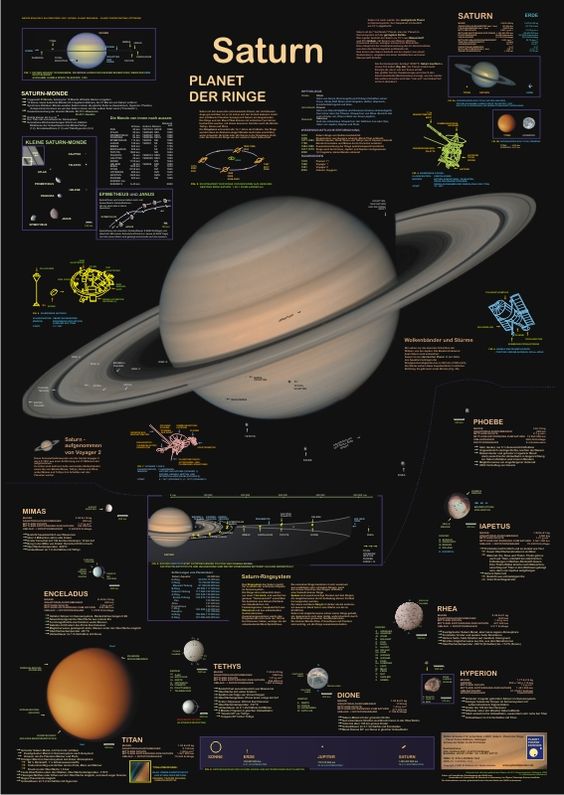

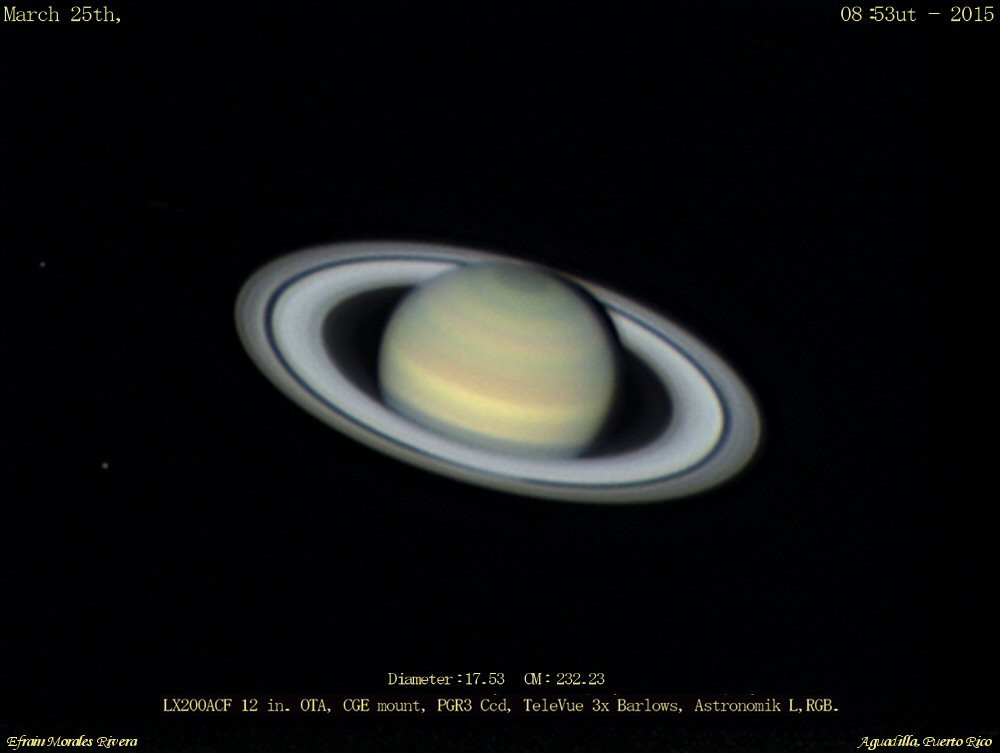
Getting closer… Saturn as seen on March 25th, 2015. Image credit and copyright: Efrain Morales
NASA's Saturn's mission page
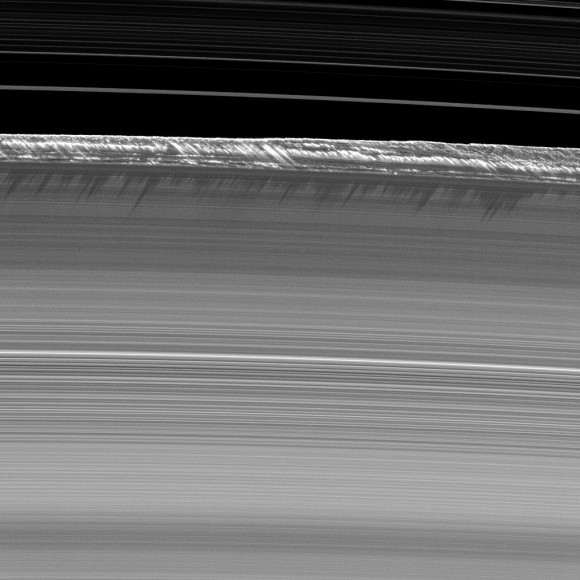

Vertical structures cause shadows on Saturn�s B ring in this July 2009 picture from the Cassini spacecraft.
Credit: NASA/JPL/Space Science Institute
From a distance, Saturn�s rings look like a sheer sheet, but peer up close and you can see that impression is a mistake.
Shadows from rubble believed to be two miles (3.2 kilometers) high are throwing shadows upon the planet�s
B ring in this image from the Cassini spacecraft.
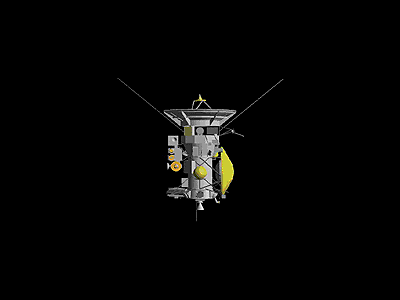
Artist's impression of Cassini-Huygens The Cassini-Huygens spacecraft is one of the largest, heaviest and most complex interplanetary spacecraft ever built.
Of all interplanetary spacecraft, only the two Phobos spacecraft sent to Mars by the former Soviet Union were heavier.
Loaded with an array of powerful instruments and cameras, the spacecraft is capable of taking accurate measurements and detailed
images in a variety of atmospheric conditions and light spectra.


iPhone cameras are good � but they aren't as good as this.
NASA's Cassini spacecraft captured this view as it approached Saturn in early 2011.
The GIF is so beautiful that it's bubbled back up to the front page of Reddit today!
A Brighter Moon
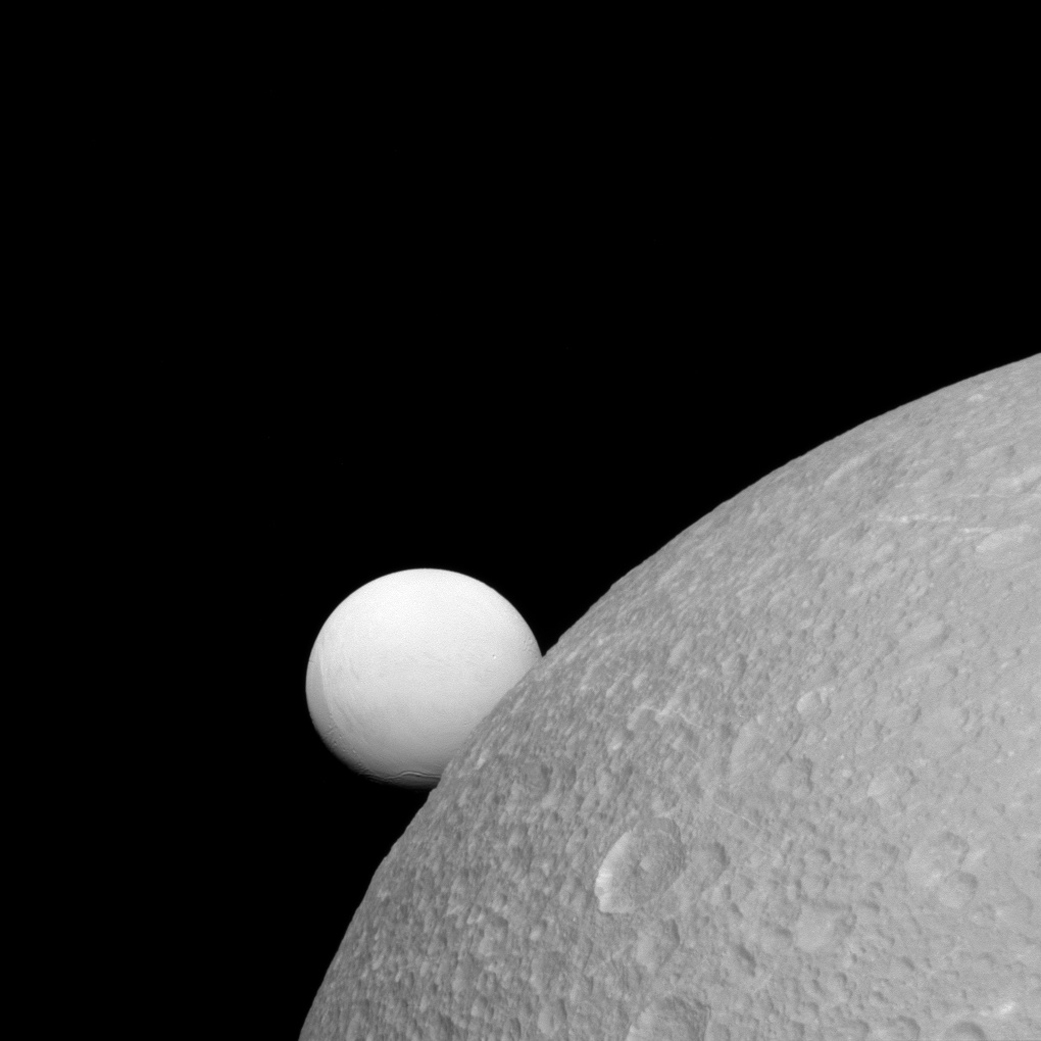
Although Dione (near) and Enceladus (far) are composed of nearly the same materials,
Enceladus has a considerably higher reflectivity than Dione.
Click here to return to top of page
Polar Cyclones on Saturn Form From Smaller Storms
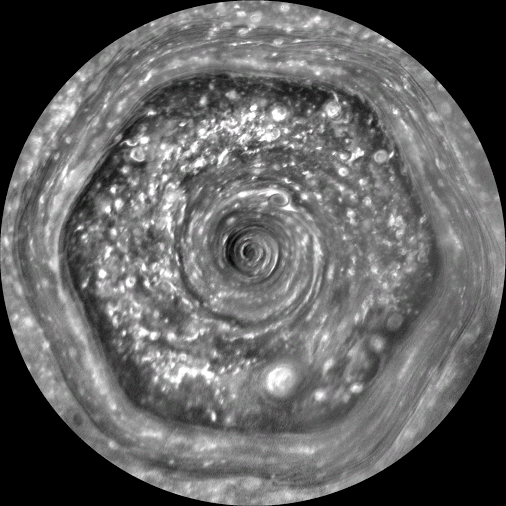
In a paper published in the journal Nature Geoscience (June 15th 2015), atmospheric scientists at MIT have proposed a mechanism for Saturn’s polar cyclones. Over time, small, short-lived thunderstorms across the planet are thought to build up angular momentum (or spin) within the atmosphere, ultimately stirring up a long-lasting vortex at the poles. Simulations carried out by Morgan O’Neill and colleagues at MIT’s Department of Earth, Atmospheric and Planetary Sciences (EAPS) show that small isolated thunderstorms pull material in Saturn's atmosphere towards the poles, accumulating atmospheric energy which then generates a much larger, long-lasting polar cyclone. The research concludes that whether or not a polar cyclone forms depends on the total energy within a planet’s atmosphere, and the average size of its thunderstorms, relative to the size of the planet. Larger thunderstorms are more likely to ultimately create the north polar cyclone that has been observed by NASA's Cassini spacecraft orbiting Saturn. Cassini Image Credit : NASA/JPL-Caltech/Space Science Institute.
In Full View: Saturn's Streaming Hexagon
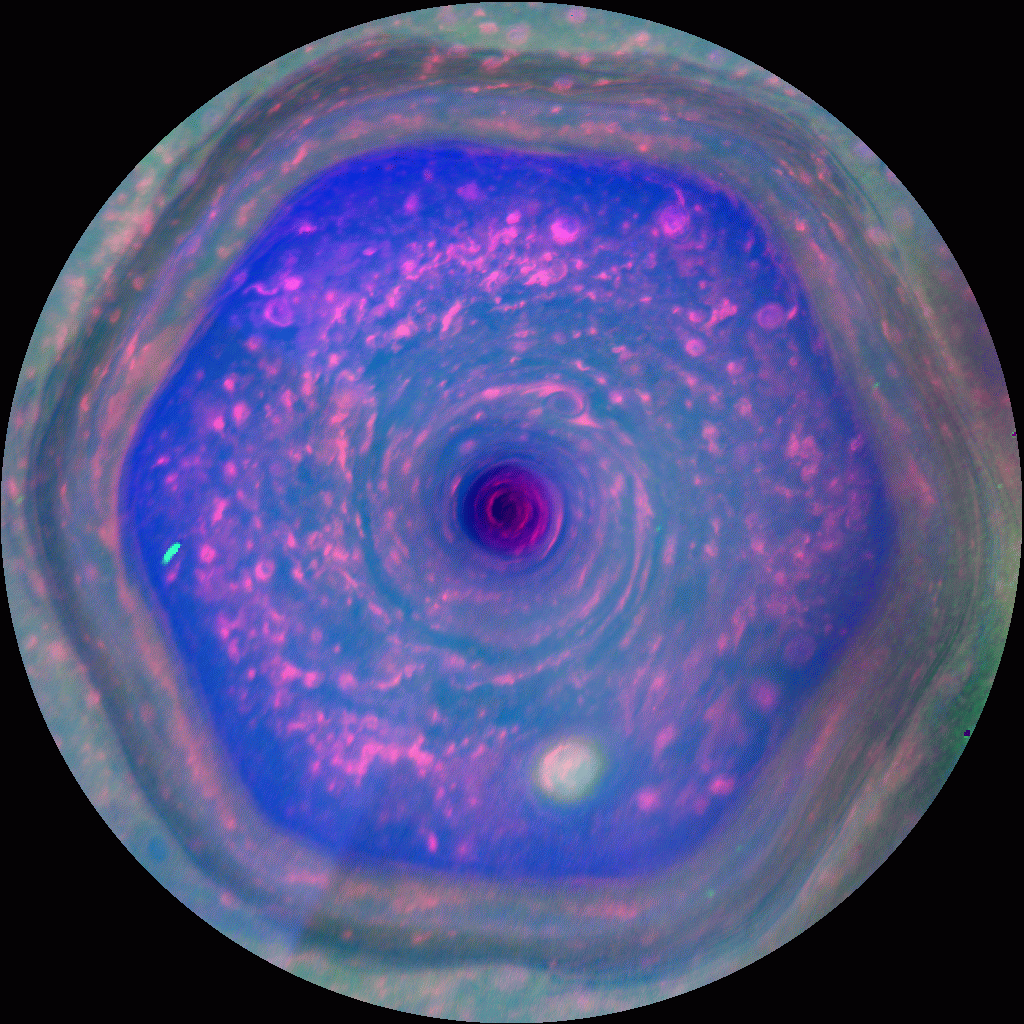
This colorful view from NASA's Cassini mission is the highest-resolution view of the unique six-sided jet stream
at Saturn's north pole known as "the hexagon." This movie, made from images obtained by Cassini's imaging cameras,
is the first to show the hexagon in color filters, and the first movie to show a complete view from the north pole down
to about 70 degrees north latitude.
IF IT WASN’T ALREADY STRANGE ENOUGH, NOW SATURN’S HEXAGON STORM IS CHANGING COLOR
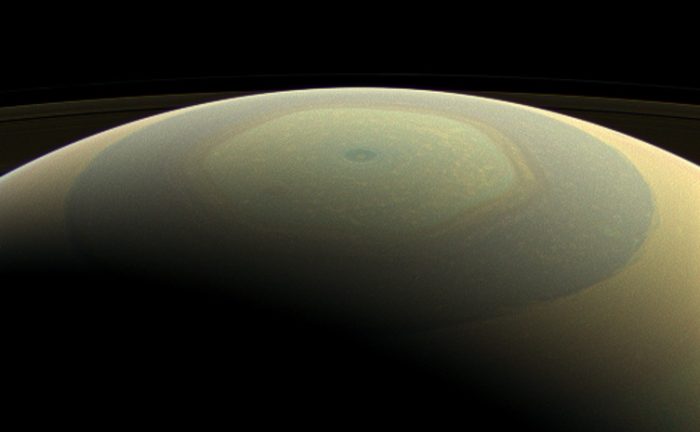
Saturn makes a beautifully striped ornament in this natural-color image, showing its north polar hexagon and central vortex
(Credit: NASA/JPL-Caltech/Space Science Institute)
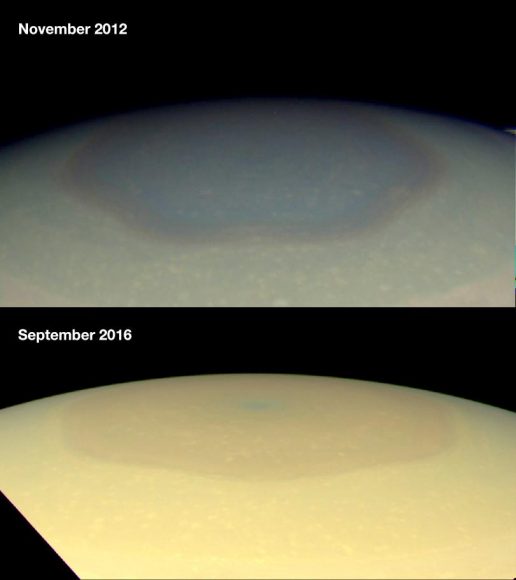
Natural color images taken by NASA’s Cassini wide-angle camera, showing the changing appearance
of Saturn’s north polar region between 2012 and 2016..
Credit: NASA/JPL-Caltech/Space Science Institute/Hampton University
SEPTEMBER 7, 2018 BY EVAN GOUGH
Cassini Data Has Revealed a Towering Hexagonal Storm at Saturn’s Northern Pole
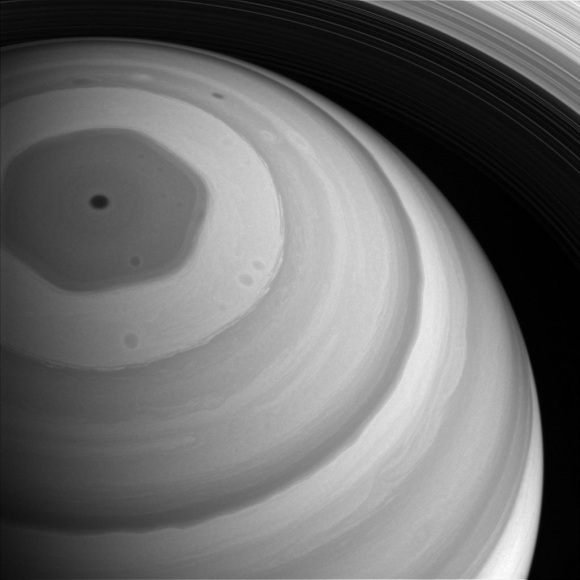
This grey-scale image of Saturn’s northern polar vortex was captured by the Cassini spacecraft. This image was captured from a distance of about 1.2 million km. A portion of Saturn’s rings are barely visible in the top right. Image: NASA/JPL-Caltech/Space Science Institute.
Saturn's Unique Hexagon in Full View
New views from NASA's Cassini spacecraft of the unique six-sided jet stream around Saturn's north pole known as "the hexagon."
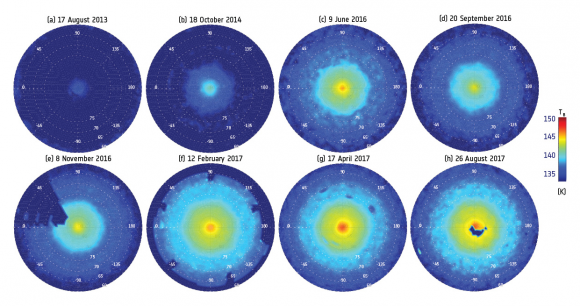
The eight frames in this composite image from Cassini’s CIRs instrument show the gradual warming of the stratosphere at Saturn north pole, and the storm taking a hexagonal shape. Image: NASA/JPL-Caltech/University of Leicester/GSFC/ L.N. Fletcher et al. 2018
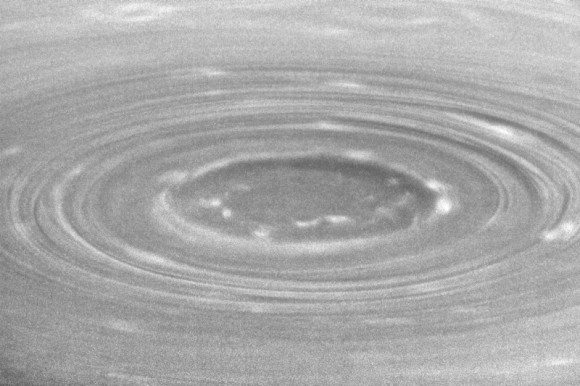
Oblique view of Saturn’s south polar vortex. The Sun is located above the top-right-hand corner, showing the shadows of clouds towering above the vortex (NASA)
Saturn's Strange Hexagon Composed of 'Sandwich' Layers
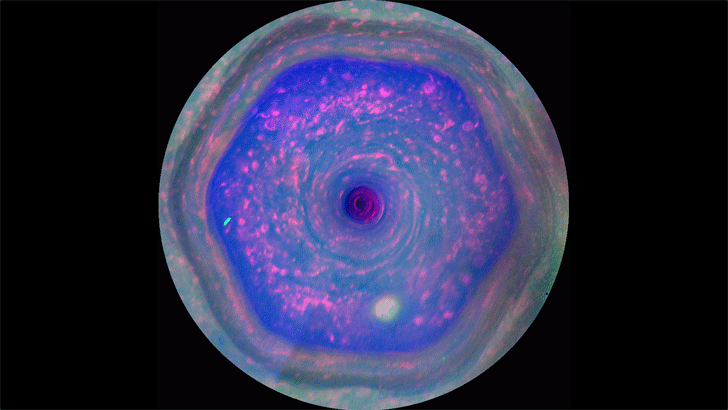
An extensive system of layers has been observed emanating above Saturn's odd hexagon feature. The hexagon, an enormous cloud structure, is situated at the giant planet's north pole. And now the Planetary Science Group at the University of the Basque Country has discovered that the hexagon is composed of a multi-layered system of at least seven mists or hazes that extend from the top of the clouds to an altitude of more than 186 miles above them.
A multilayer haze system on Saturn's hexagon
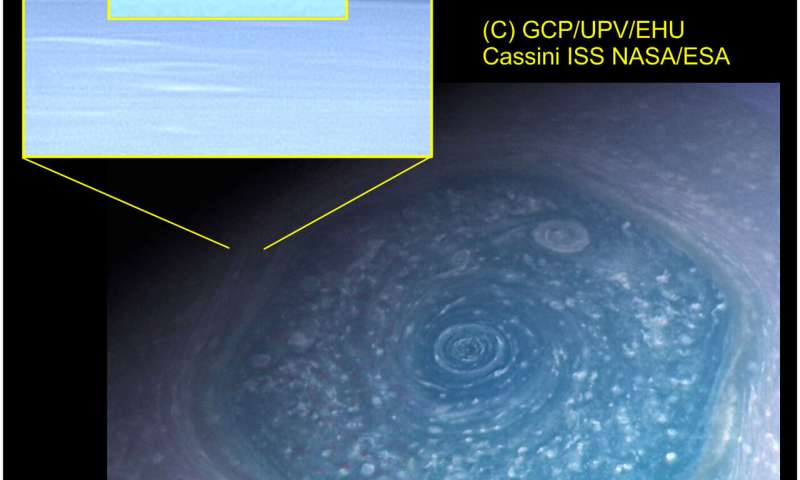
Credit: University of the Basque Country A rich variety of meteorological phenomena takes place in the extensive hydrogen atmosphere of Saturn, a world about 10 times the size of the Earth. They help us to better understand similar features in the Earth's atmosphere. Among Saturn's atmospheric phenomena is the well-known "hexagon," an amazing wave structure that surrounds the planet's polar region.
NEW COMPOSITE IMAGEs OF SATURN’S SOUTHERN POLAR VORTEX MESMERIZES
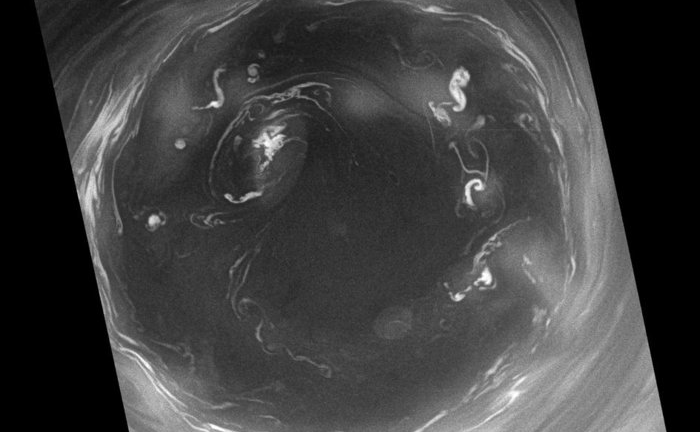
This image of Saturn's southern polar vortex reveals previously unseen detail of the giant storm.
Image: NASA/JPL/Space Science Institute
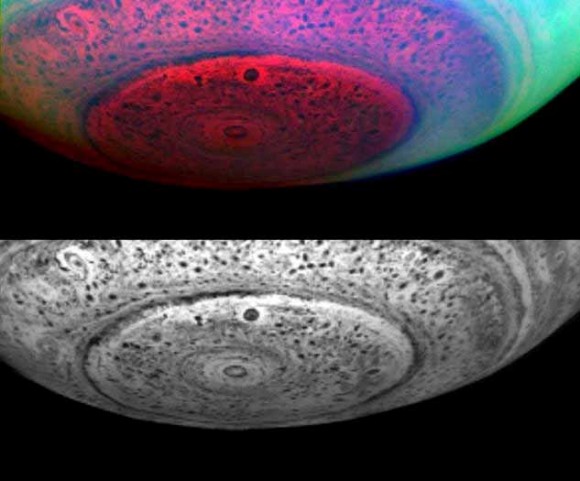
These two previously released infrared images of Saturn show the entire south polar region
with the hurricane-like vortex in the center. The top image shows the polar region in false color,
with red, green, and blue depicting the appearance of the pole in three different near-infrared colors
(NASA/JPL/University of Arizona)
Saturn's F Ring in Motion
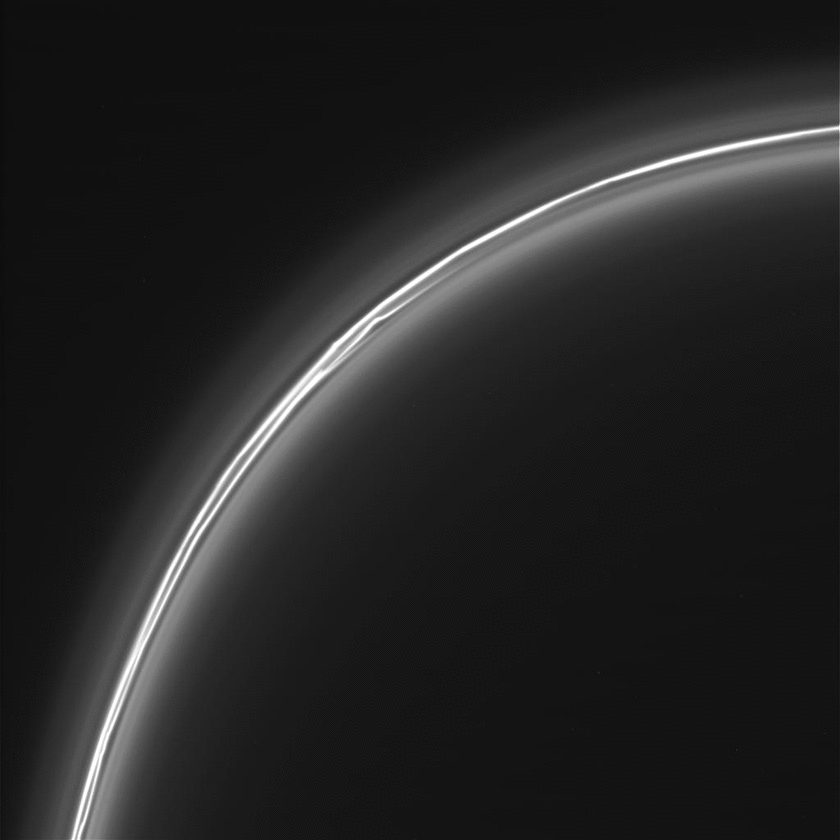
Saturn's F Ring: billions of icy particles strung into ropy filaments by the gravity of small
shepherd moons, and set aglow by sunlight. This sequence of images was captured by Cassini on February 14, 2013.
I've removed some of the visual noise caused by cosmic rays hitting the imaging sensor.
NASA/JPL/Space Science Institute/Bill Dunford Copyright holder: Bill Dunford

Click here to return to top of page
This section for the Cassini Mission to Saturn
Cassini Mission Infographics


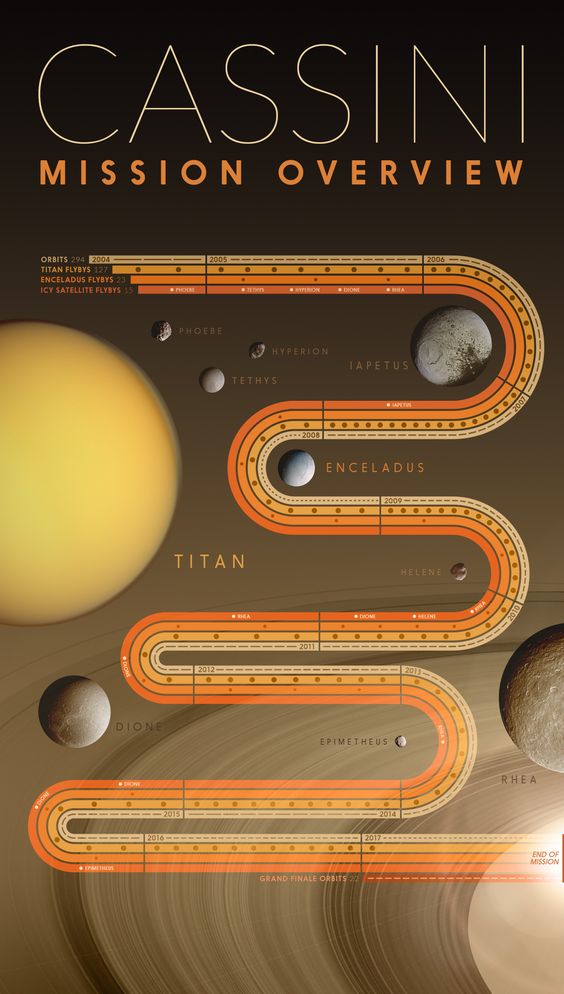
The Cassini-Huygens Probe - Mission To Titan
The Cassini-Huygens Probe - Final Assembly
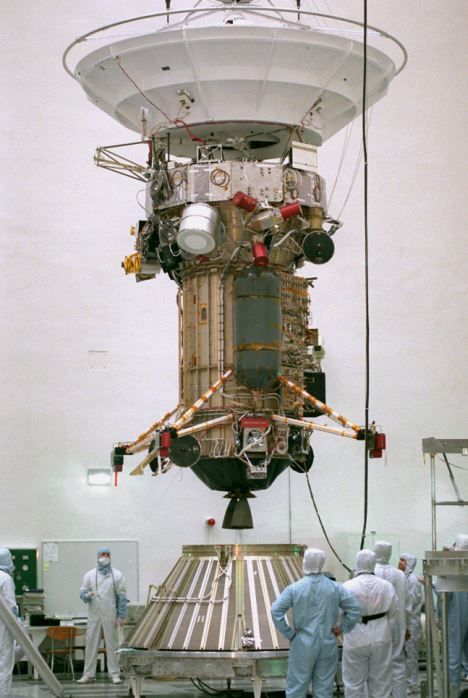
Uploaded on Jul 26, 2011
For more like this subscribe to the Open University channel
Free learning from The Open University
Adam Hart-Davies introduces one of the most ambitious space exploration missions ever launched.
-Playlist link
Transcript link -
Study 'Astronomy' with the OU
Study 'Planetary science and the search for life' with the OU
Routing Cassini through space to Titan - BBC
Uploaded on Jul 24, 2007 To get enough speed to reach Titan, Cassini would have to use other planets as sling-shots to propel her out into the far reaches of our solar system. Scientists explain how this is done in this fascinating BBC clip.
The Present position of Cassini
Looking down on cassini:

Cassini Pictures Of Saturn And Its Moons
11 Years of Cassini Saturn Photos in 3 hrs 48 min
Published on Nov 20, 2015 341,805 images taken by Cassini's Imaging Science Subsystem (ISS) from the Saturn EDR Data Sets (Volumes 1-93).
This includes all of Cassini's Photos from February 6, 2004 - September 15, 2015.
Compiled and processed by The Wall Street Journal’s @JonKeegan.
NOTE: These raw, unedited sequences at times include rapid flashing. If you have photosensitive epilepsy,
or a similar condition, this could trigger a physical reaction. Please use caution when watching this footage. See more News & Politics License Standard YouTube License
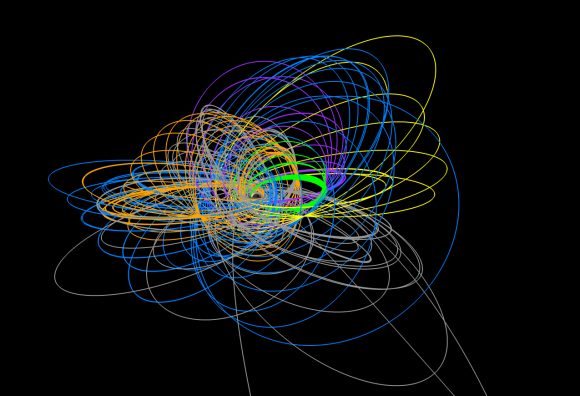
A computer-generated representation of all Cassini’s Saturn orbits -affectionately called the “ball of yarn” by mission planners. The time frame spans Saturn Orbit Insertion on July 1, 2004 to the end of mission on Sept. 15, 2017. Credit: NASA/JPL-Caltech.

Artist’s concept of Cassini orbiter crossing Saturn’s ring plane. Credit: NASA/Jet Propulsion Laboratory.
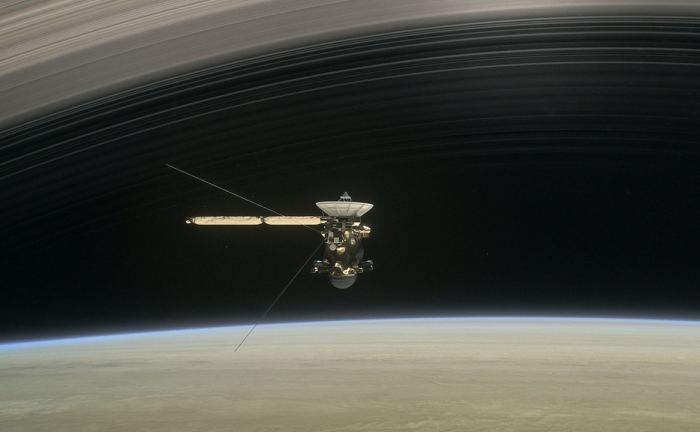
Artist's concept of Cassini diving between Saturn and its innermost ring. Credit: NASA/JPL-Caltech
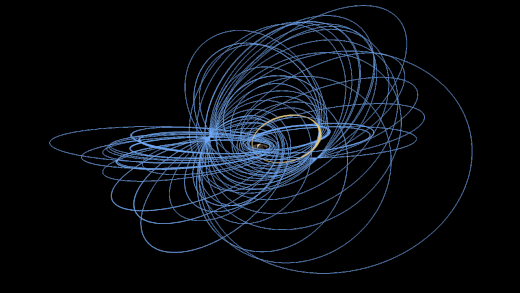
Image: Cassini crosses Saturn’s F ring once on each of its 20 Ring-Grazing Orbits, shown here in tan and lasting from late November 2016 to April 2017. Blue represents the extended solstice mission orbits, which precede the ring-grazing phase. Credit: JPL. That grazing will include two passes directly through a tenuous ring created by meteor strikes on the small moons Janus and Epimetheus. Each orbit will cross the ring plane just outside the F ring, considered to be the boundary of the main ring system, with Cassini actually moving through the outer edges of the F ring in April. Here the science should be particularly interesting — the 800-kilometer wide F ring is malleable, developing and dispersing filament-like structures, dark channels and streamers over short periods of time.
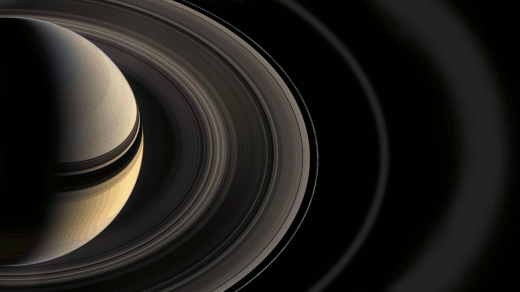
Image: Saturn’s rings were named alphabetically in the order they were discovered. The narrow F ring marks the outer boundary of the main ring system. Credit: NASA/JPL-Caltech/Space Science Institute. The distances involved in this phase of the mission are worth noting. The new orbits will take the craft within 90,000 kilometers of the planet’s cloud tops, but the Grand Finale phase, scheduled to begin next April, closes to within 1628 kilometers. This should be breathtaking, for the craft will move again and again through the gap between Saturn and the rings before making its final plunge into the atmosphere on September 15. Preparations for this final phase begin with a main engine burn on December 4. This is an engine that has served us well — this will be its 183rd burn — but the remainder of the mission will be handled with thrusters.
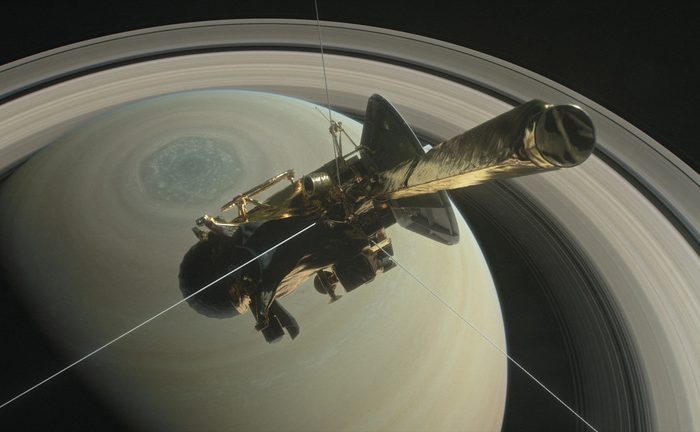
This illustration shows Cassini above Saturn's northern hemisphere prior to one of its 22 Grand Finale dives. Credit: NASA/JPL-Caltech
Published on Apr 4, 2017 The final chapter in a remarkable mission of exploration and discovery, Cassini's Grand Finale is in many ways like a brand new mission. Twenty-two times, NASA's Cassini spacecraft will dive through the unexplored space between Saturn and its rings. What we learn from these ultra-close passes over the planet could be some of the most exciting revelations ever returned by the long-lived spacecraft. This animated video tells the story of Cassini's final, daring assignment and looks back at what the mission has accomplished. For more about the making of this video, including the science behind the imagery, see the feature at The Cassini mission is a cooperative project of NASA, ESA (the European Space Agency) and the Italian Space Agency. The Jet Propulsion Laboratory, a division of the California Institute of Technology in Pasadena, manages the mission for NASA's Science Mission Directorate, Washington. For more information about Cassini's Grand Finale, please visit Category Science & Technology License Standard YouTube License

Cassini vs. Saturn. As depicted in this illustration, Cassini will plunge into Saturn’s atmosphere on Sept. 15, 2017. Using its attitude control thrusters, the spacecraft will work to keep its antenna pointed at Earth while it sends its final data, including the composition of Saturn’s upper atmosphere. Credit: NASA/JPL-Caltech
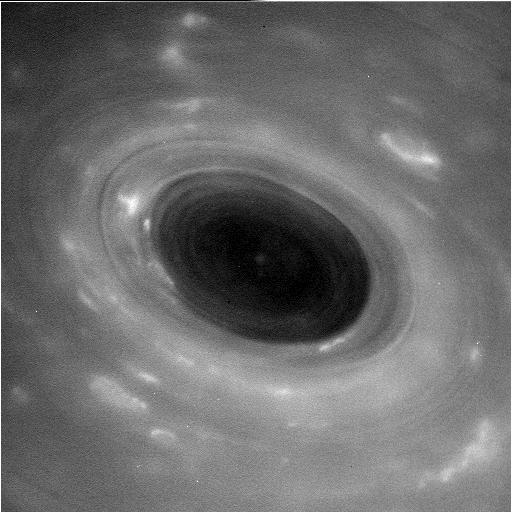
A raw image of Saturn’s polar vortex, taken on April 26, 2017 by the Cassini spacecraft during the first close pass between Saturn and its rings. Credit: NASA/JPL-Caltech.

Artist concept of Cassini's last moments at Saturn. Credit: NASA/JPL.
After nearly 20 years, hundreds of thousands of photos, hundreds of flybys, and thousands of scientific papers, it’s time to say goodbye to Cassini. In this special video, we team up with David Joseph Wesley to say farewell to one of the most important scientific instruments humanity has ever built.
NASA Cassini's Final Images of Saturn Stunned Me
In 2017, Cassini ended its mission by disintegrating in Saturn's atmosphere. What were the final images it ever took? GET NORDVPN: USE COUPON CODE: astrum USE THE CODE SO YOU CAN GET 70% off 3-year plan + 1 additional month FREE. : NordVPN YT Astrum merch now available! SUBSCRIBE for more videos about our other planets. Subscribe! ! Facebook Twitter! : Astrum Hindi: Astrum Spanish: Astrum Portuguese: Donate! Patreon: A HREF="https://goo.gl/GGA5xT"> Ethereum Wallet: 0x5F8cf793962ae8Df4Cba017E7A6159a104744038 Become a Patron today and support my channel! Donate link above. I can't do it without you. Thanks to those who have supported so far! Image Credits: NASA Music Credits: Anima - The Waning Moon Andrew Odd - Leaving

Cassini program manager at JPL, Earl Maize, left, and spacecraft operations team manager for the Cassini mission at Saturn, Julie Webster, right, embrace after the Cassini spacecraft plunged into Saturn, Friday, Sept. 15, 2017 at NASA’s Jet Propulsion Laboratory in Pasadena, California. Photo Credit: (NASA/Joel Kowsky)
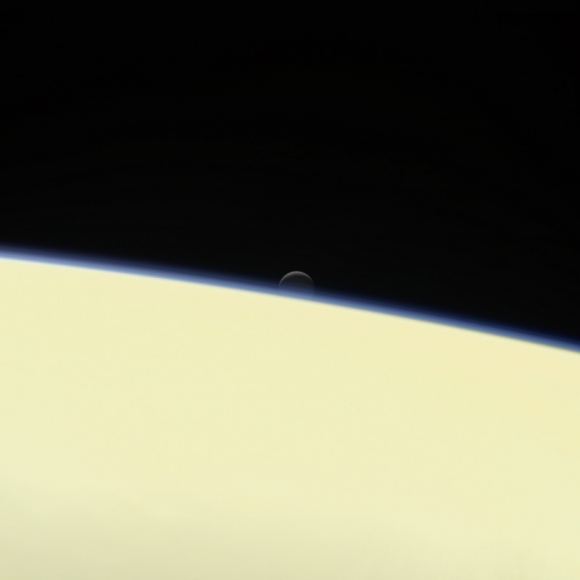
Saturn’s active, ocean-bearing moon Enceladus sinks behind the giant planet in a farewell portrait from NASA’s Cassini spacecraft. Credits: NASA/JPL-Caltech/Space Science Institute
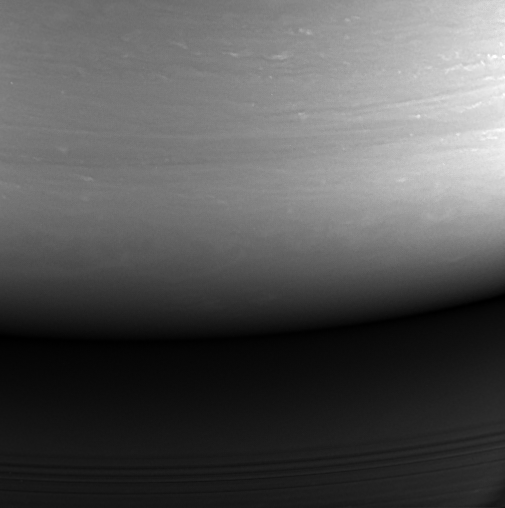
This monochrome view is the last image taken by the imaging cameras on NASA’s Cassini spacecraft. It looks toward the planet’s night side, lit by reflected light from the rings, and shows the location at which the spacecraft would enter the planet’s atmosphere hours later. Credit: NASA/JPL-Caltech/Space Science Institute
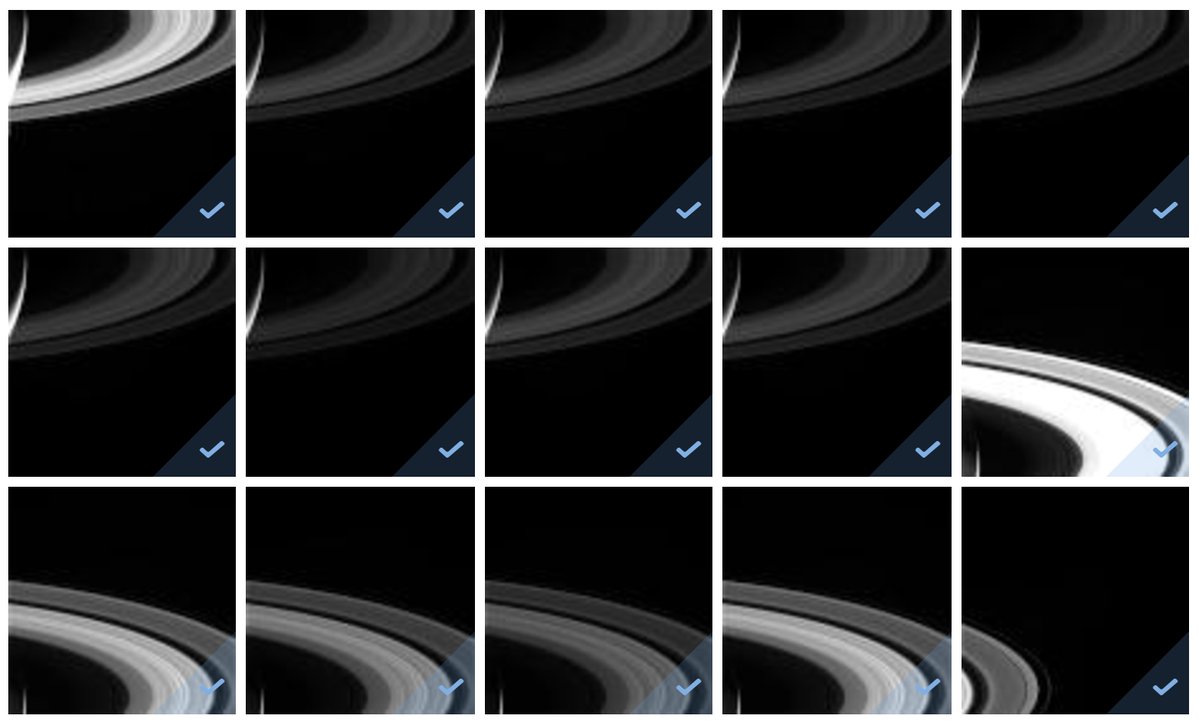
The final images from our nearly 20 years in space are arriving. Unprocessed images are available at: Unprocessed images are available at
Team members reflect on what has made the NASA/ESA Cassini mission such an epic journey -- the extraordinary spacecraft, tremendous science and historic international collaboration. This video uses a combination of animation and actual imagery returned over the course of the mission. For more information about the Cassini mission, visit . For specific information about the mission's Grand Finale, visit
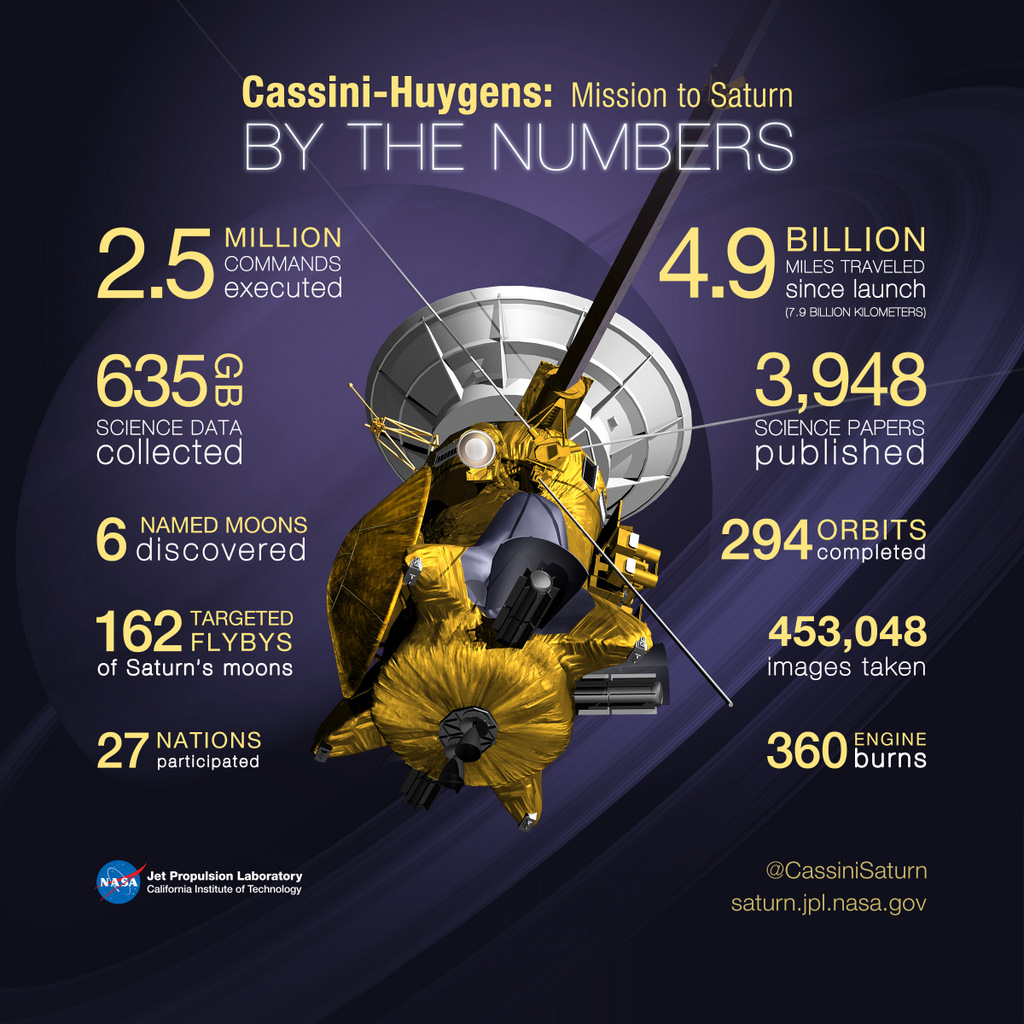
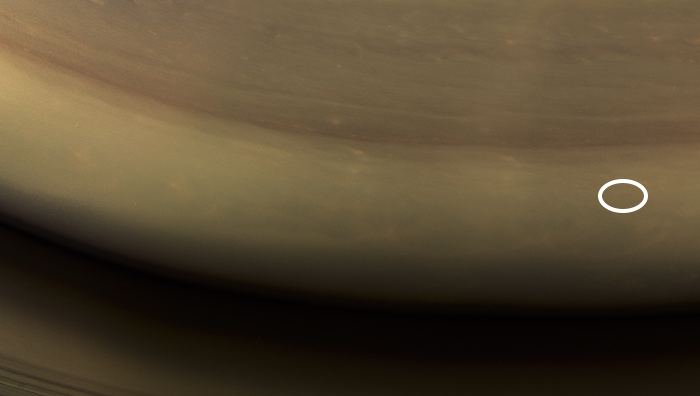
The site of the Cassini probe's crash in Saturn's atmosphere, circled in white. Credit: NASA/JPL-Caltech/Space Science Institute
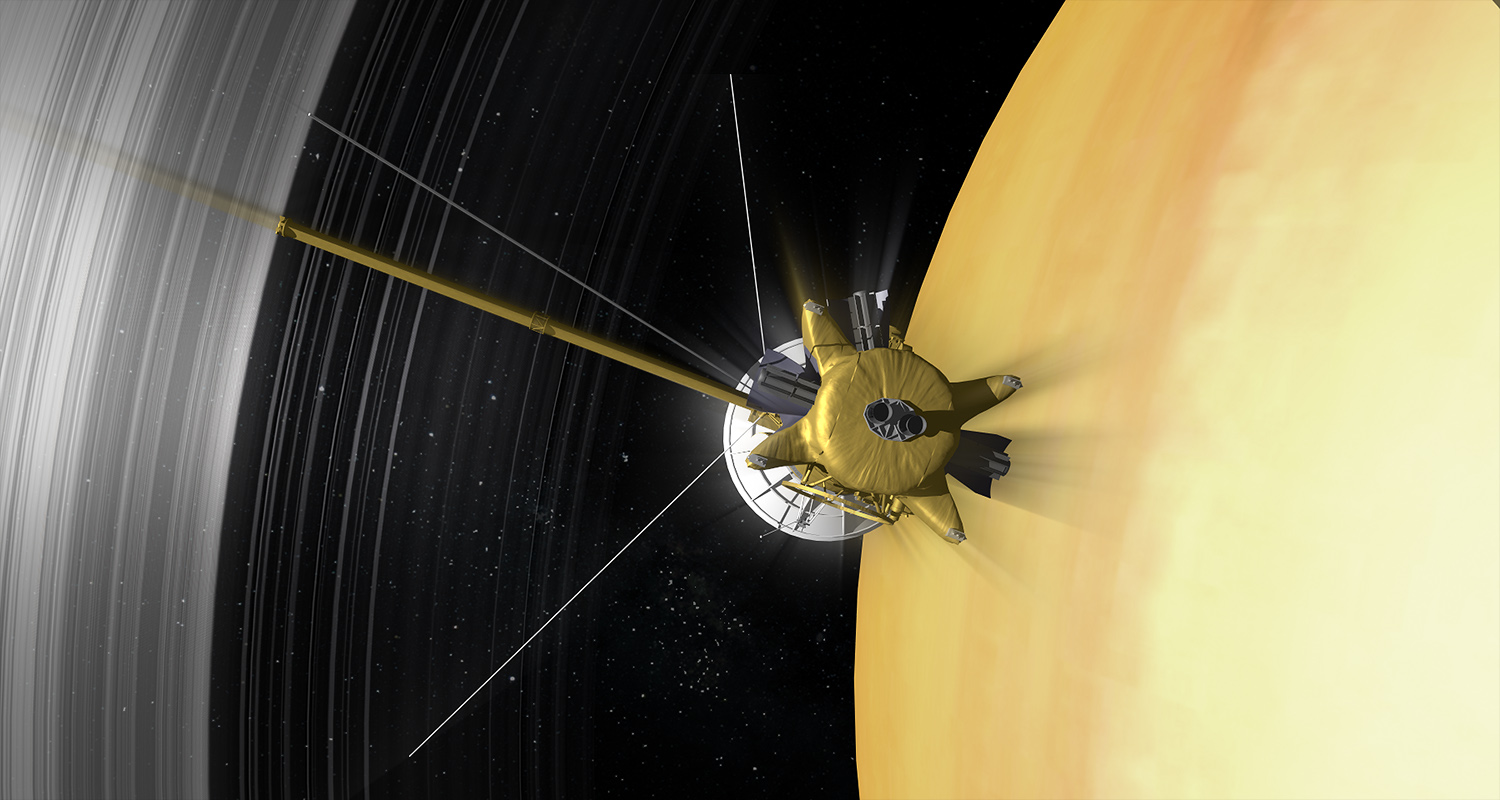
Artist’s impression of the Cassini spacecraft orbiting Saturn. Credit: NASA/JPL-Caltech/Space Science Institute
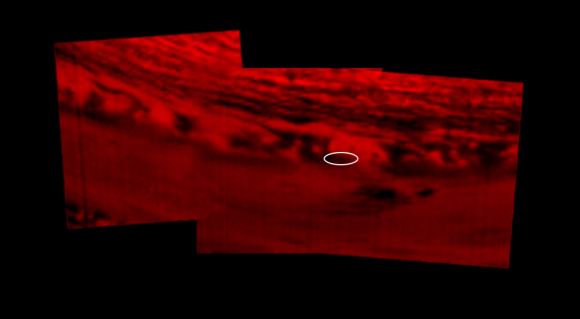
This montage of images, made from data obtained by Cassini’s visual and infrared mapping spectrometer, shows the location on Saturn where the NASA spacecraft entered Saturn’s atmosphere on Sept. 15, 2017. Credits: NASA/JPL-Caltech/University of Arizona
After nearly 20 years, hundreds of thousands of photos, hundreds of flybys, and thousands of scientific papers, it’s time to say goodbye to Cassini. In this special video, we team up with David Joseph Wesley to say farewell to one of the most important scientific instruments humanity has ever built.
Mission planning is a core strength of JPL engineering, along with deep space communications and navigation. This talk looks back at the various scenarios and contingency plans the Cassini team made as they steered the spacecraft into unexplored space during its 2017 Grand Finale at Saturn. Sturm discussed how the possible scenarios -- some of which could have been mission-ending -- compared to the mission as it was actually flown, along with some science highlights from the finale.
Click here to return to top of page
Saturn's Moon Hyperion
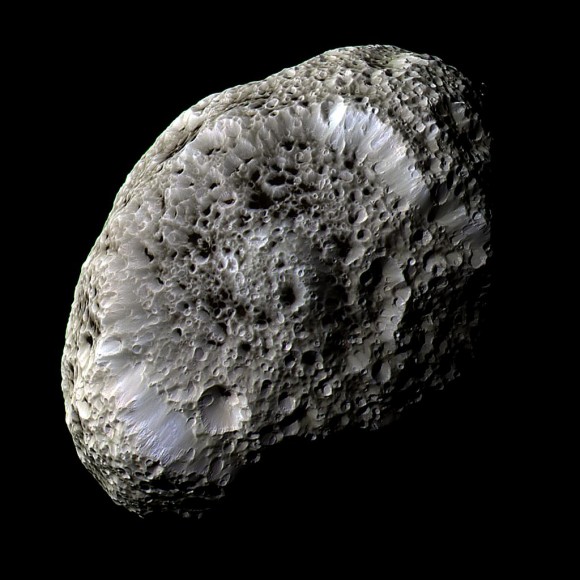
A false-color view of Saturn�s moon Hyperion taken during a Cassini flyby in September 2005.
CREDIT: NASA/JPL-Caltech/Space Science Institute
Ever taken a balloon and rubbed it against your hair? That�s an example of electrostatic charging,
which you see as the balloon briefly attracts strands of hair against your head.
Turns out a similar process is taking place on Saturn�s moon Hyperion. More astounding,
it wasn�t until recently that scientists saw a curious effect on the Cassini spacecraft in 2005.
It’s chaos at Saturn’s moon Hyperion
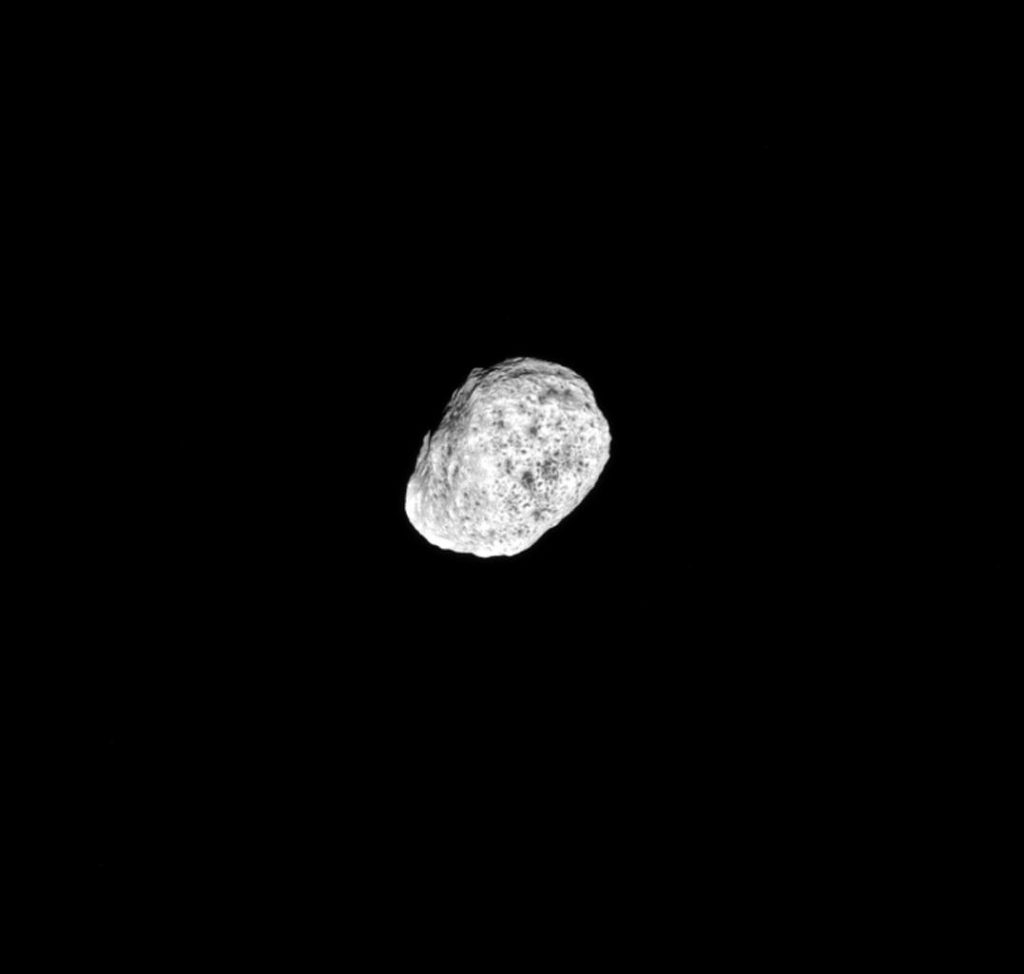
Image: NASA/JPL-Caltech/Space Science Institute. The moon Hyperion tumbles as it orbits Saturn. Hyperion’s (270 kilometres or 168 miles across) spin axis has a chaotic orientation in time, meaning that it is essentially impossible to predict how the moon will be spinning in the future. So far, scientists only know of a few bodies with such chaotic spins. The image was taken in green light with the Cassini spacecraft narrow-angle camera on 22 August 2016.
Click here to return to top of page
Saturn Smackdown! Icy Moons Burned By Radiation And Ions
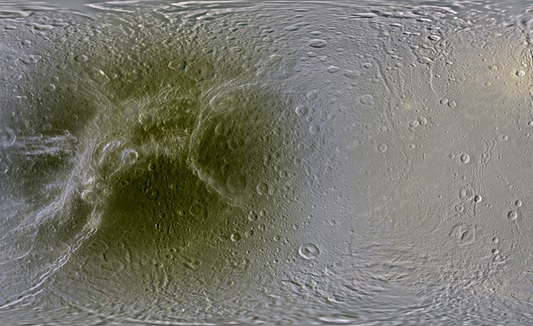
This global map of Dione, a moon of Saturn, shows dark red in the trailing hemisphere, which is due to radiation and charged particles from
Saturn�s intense magnetic environment. Credit: NASA/JPL/Space Science Institute
If you hang out in Saturn�s intense magnetic environment for a while, it�s going to leave a mark.
That�s one conclusion from scientists who proudly released new maps yesterday (Dec. 9)
of the planet�s icy moons, showing dark blotches on the surfaces of Dione, Rhea, and Tethys.
A close look at Saturn's closest moons
Posted By Emily Lakdawalla
2014/06/27 01:13 UTC
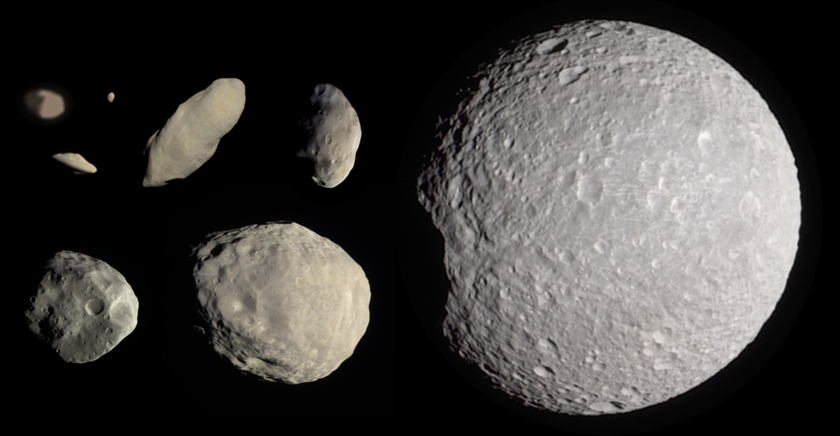
NASA / JPL / SSI / Gordan Ugarkovic / Emily Lakdawalla
Saturn's innermost moons: Pan, Daphnis, Atlas, Prometheus, Pandora, Epimetheus, Janus, and Mimas, to scale
The eight innermost moons of Saturn, in color images collected by Cassini between June 7, 2005, and July 5, 2010.
Pan and Daphnis (top left small moons) orbit within the Encke and Keeler gaps in the rings;
Atlas (below Pan and Daphnis) orbits at the outer edge of the main rings. To their right are Prometheus and Pandora;
Prometheus orbits just inside and Pandora just outside the F ring. Below them are Epimetheus (left) and Janus (right),
which trade positions every four years, averaging out to the same distance from Saturn. Mimas orbits considerably farther away,
but its gravitational effects influence the positions of gaps and waves within the rings.
At full resolution, the montage has a scale of 500 meters per pixel.
Janus Stands Alone

uch as its name implies, tiny Epimetheus (Greek for hindsight) was discovered in hindsight.
Astronomers originally thought that Janus and Epithemeus were the same object.
Only later did astronomers realize that there are in fact two bodies sharing the same orbit!
Janus (111 miles or 179 kilometers across) and Epimetheus (70 miles or 113 kilometers)
have the same average distance from Saturn, but they take turns being a little closer or a little farther from Saturn,
swapping positions approximately every 4 years. See PIA08348 for more.
This view looks toward the sunlit side of the rings from about 29 degrees above the ringplane.
The image was taken in visible light with the Cassini spacecraft narrow-angle camera on Jan. 1, 2015.
The view was acquired at a distance of approximately 1.8 million miles (2.9 million kilometers)
from Epimetheus and at a Sun-Epimetheus-spacecraft, or phase, angle of 89 degrees.
Image scale is 11 miles (17 kilometers) per pixel.
The Cassini mission is a cooperative project of NASA, the European Space Agency and the Italian Space Agency.
The Jet Propulsion Laboratory, a division of the California Institute of Technology in Pasadena,
manages the mission for NASA's Science Mission Directorate, Washington, D.C.
The Cassini orbiter and its two onboard cameras were designed, developed and assembled at JPL.
The imaging operations center is based at the Space Science Institute in Boulder, Colo.
For more information about the Cassini-Huygens mission visit
and For more information about the Cassini-Huygens mission visit
AND The Cassini imaging team homepage Credit: NASA/JPL-Caltech/Space Science Institute Last Updated: July 30, 2015 Editor: Tony Greicius
Click here to return to top of page
Saturn's Moon Rhea
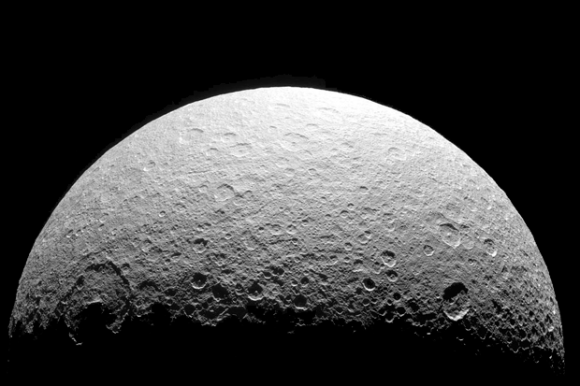
Saturn's Mystery World You Know Nothing About | Our Solar System's Moons: Rhea
We marvel at Rhea, Saturn's second largest moon. Get NordVPN 2Y plan + 4 months extra ➼ It’s risk-free with Nord’s 30-day money-back guarantee! Astrum Podcast: Displate Posters: Astrum Merch! Join the official Astrum discord server: SUBSCRIBE for more videos about space and astronomy. Subscribe! Facebook! Twitter! A huge thanks to our Patreons who help make these videos possible. Sign-up here: Astrum Spanish: Astrum Portuguese:/ @astrumbrasil Credits Writer: Jon McColgan Editor: Nick Shishkin Thumbnail Designer: Peter Sheppard Producer: Alex McColgan / Raquel Taylor NASA/ESO/ESA #astrum #astronomy #space #solarsystem #saturn #moon #cassini #rhea
Saturn’s moon Rhea, as imaged by the Cassini-Huygens spacecraft. Credit: NASA/JPL-Caltech
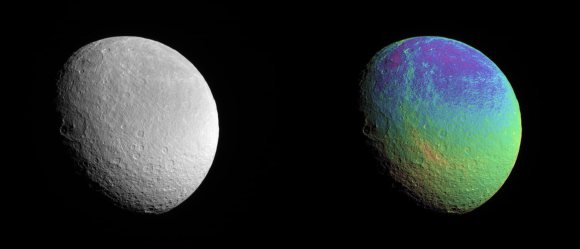
Views of Saturn’s moon Rhea, with false-color image showing elevation data at the right.
Credit: NASA/JPL/Space Science Institute
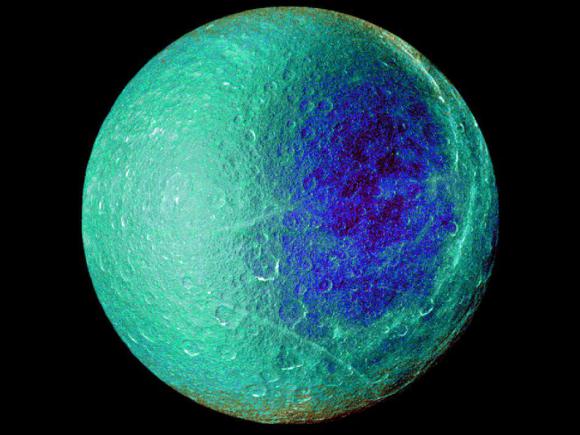
Hemispheric color differences on Saturn’s moon Rhea are apparent in this false-color view of the anti-Cronian side,
from NASA’s Cassini spacecraft. Image Credit: NASA/JPL/SSI
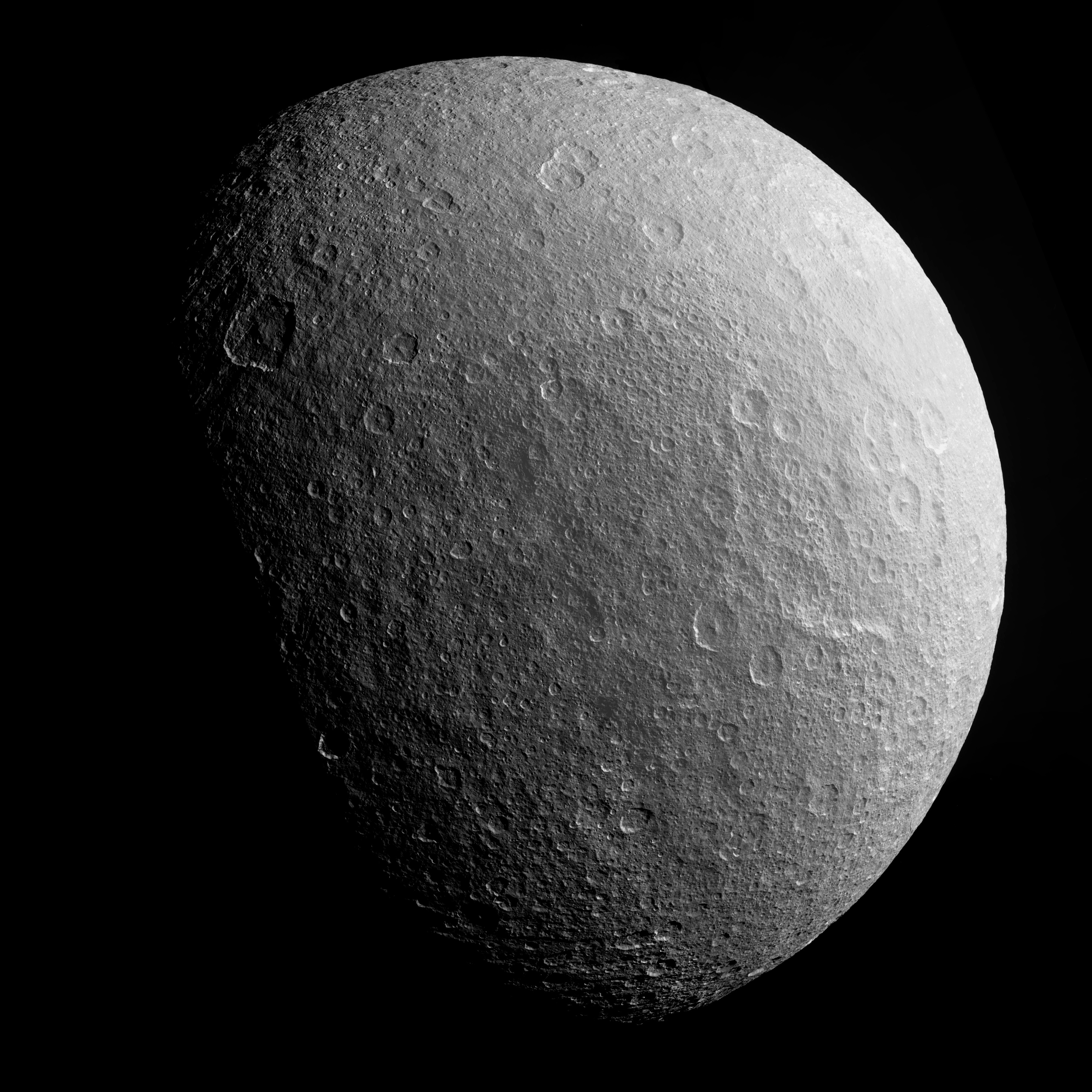
Northern Rhea
Saturn's Moon Rhea and Tethys
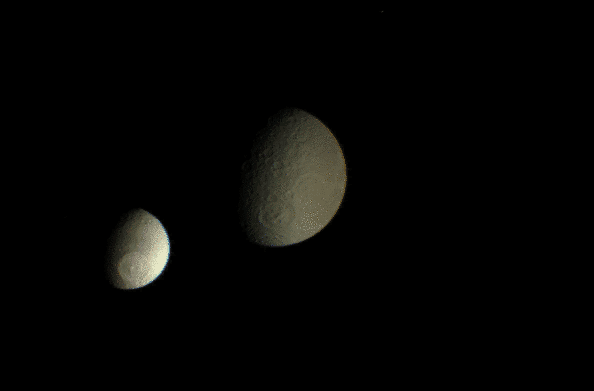
MEETING OF TETHYS AND RHEA
Click here to return to top of page
Saturn's Moon Tethys
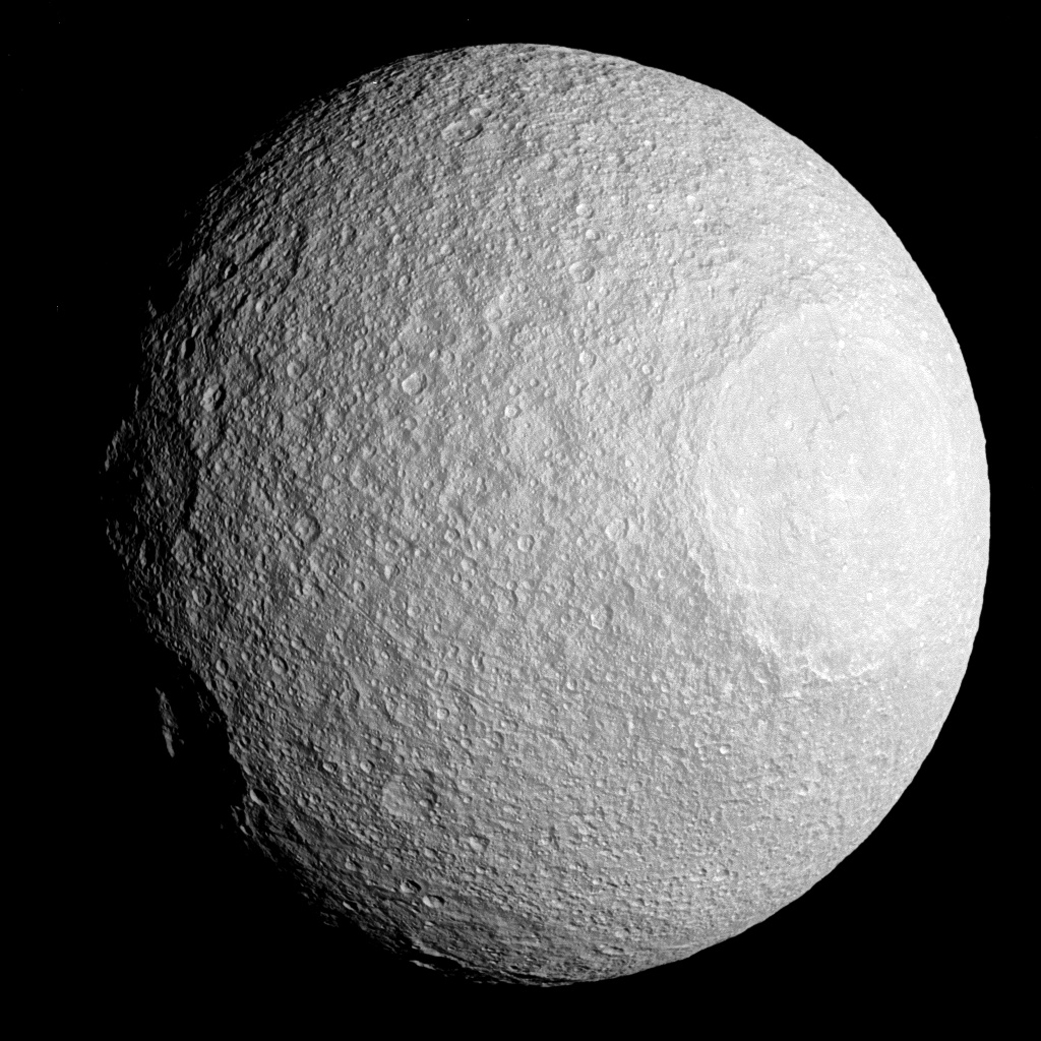
Like most moons in the solar system, Tethys is covered by impact craters.
Some craters bear witness to incredibly violent events, such as the crater Odysseus
(seen here at the right of the image). The image was taken in visible light with the
Cassini spacecraft narrow-angle camera on April 11, 2015.
Bookmark and Share
What Cassini Discovered on the Surface of Tethys Stunned Scientists | Our Solar System's Moons
Try Opera for a faster, smarter browsing experience. Click the link to explore it for free: ▀▀▀▀▀▀ What could survive an impact so massive it should have shattered the entire world into pieces? Saturn's scarred survivor Tethys holds dark secrets - a massive crater that spans half its diameter, a colossal trench wrapping around its body, and a bizarre thermal anomaly that looks just like Pac-Man. In this video, we uncover the shocking secrets frozen in Tethys' icy shell and discover how this scarred world became one of the solar system's most remarkable survivors. ▀▀▀▀▀▀ 1:30 Discovery 2:19 The Ice World 4:19 Ithaca Chasma: The Great Crack 5:14 Bursting Open 8:12 Odysseus Crater 9:15 Healing Ancient Scars 12:09 The Pac-Man Phenomenon 13:15 Why Does Tethys Look Like Pac-Man? 15:58 The Survivor ▀▀▀▀▀▀ Subscribe to our new channel!Astrum Earth: / @astrumearth ▀▀▀▀▀▀ Astrum Podcast Astrum Infographic Artwork: Astrum Displate Posters: Astrum Merch: Join us on the Astrum discord: / discord A huge thanks to our Patreons who help make these videos possible. Sign-up here:Patreon: Astrum Spanish: Astrum Portuguese:/ @astrumbrasil ▀▀▀▀▀▀ References: “Tethys”, via nasa.gov “Cassini captures Tethys in all her glory”, via newscientist.com “Photometric Modeling and VIS-IR Albedo Maps of Tethys From Cassini-VIMS”, via wiley.com (PDF) “Cassini's geological and compositional view of Tethys”, via sciencedirect.com “The Geology of Tethys”, via harvard.edu “Small Impact Crater Populations on Saturn's Moon Tethys and Implications for Source Impactors in the System”, via wiley.com “Plasma, plumes and rings: Saturn system dynamics as recorded in global color patterns on its midsize icy satellites”, via sciencedirect.com “PacMan returns: An electron-generated thermal anomaly on Tethys”, via sciencedirect.com “A Pair of ‘Pac-Men’”, via nasa.gov ▀▀▀▀▀▀ Credits: Writer: Jon McColgan Video Editor: Nick Shishkin Researcher: Edie Abrahams Thumbnail Designer: Peter Sheppard Channel Manager: Georgina Brenner Executive Producer: Raquel Taylor Creator of Astrum: Alex McColgan With special thanks to: NASA/ESO/ESA
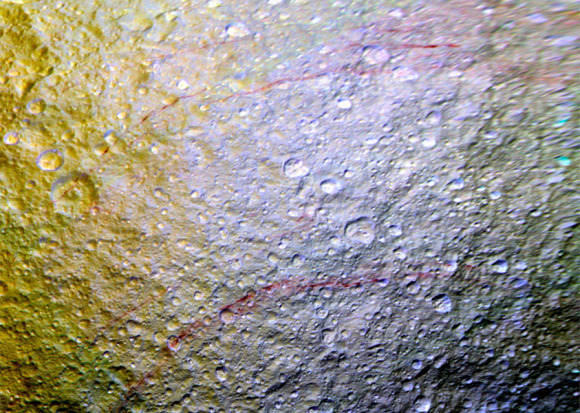
Enhanced-color image from Cassini showing red streaks on Saturn’s moon Tethys
(Credit: NASA/JPL-Caltech/Space Science Institute)
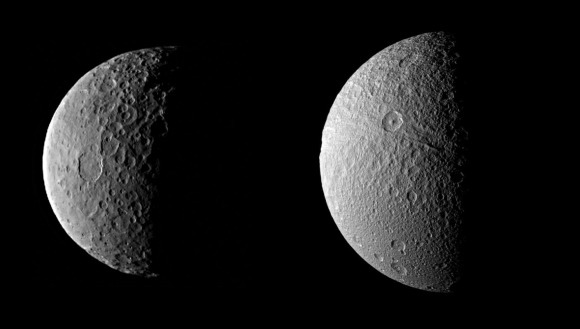
Ceres (left, Dawn image) compared to Tethys (right, Cassini image) at comparative scale sizes.
(Credits: NASA/JPL-Caltech/UCLA/MPS/DLR/IDA and NASA/JPL-Caltech/SSI. Comparison by J. Major.)
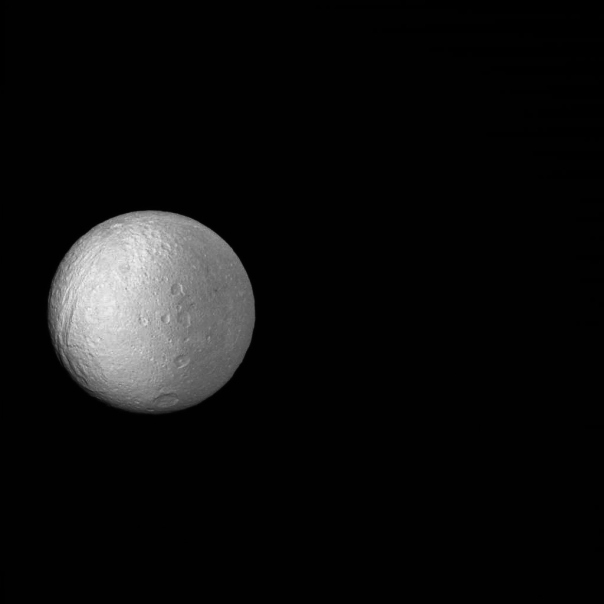
Frozen, airless Tethys
662-mile-wide Tethys, as seen by Cassini on March 3, 2010.
Part of the 1200-mile-long Ithaca Chasma can be seen on its western edge,
running north to south. With a density .97 times that of liquid water, Tethys is almost completely made of ice.
Image has been adjusted to bring out surface details.
Image: NASA/JPL/Space Science Institute
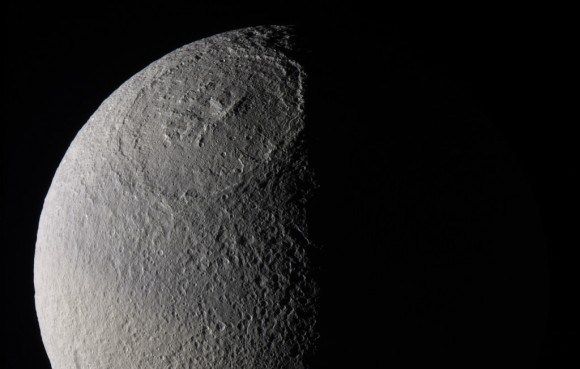
The Odysseus Crater, the 400 km surface feature that gives Tethys it’s “Death Star” appearance. Credit: NASA/JPL/SSI
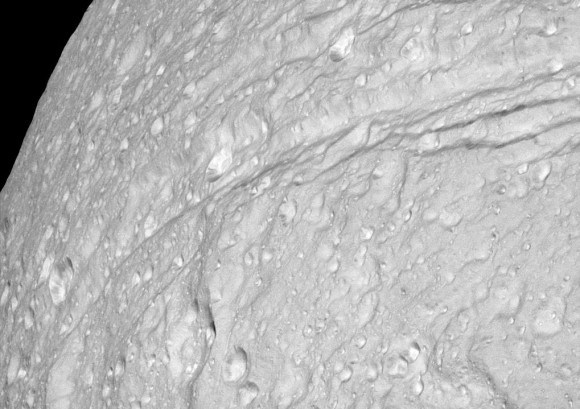
Cassini closeup of the southern end of Ithaca Chasma. Credit: NASA/JPL/Space Science Institute.
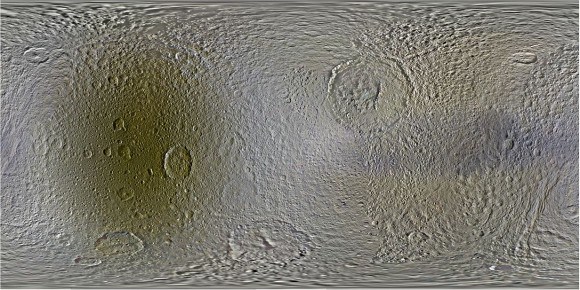
Global, color mosaics of Saturn’s moon Tethys, as produced from images taken by NASA’s Cassini spacecraft between 2004-2014.
Credit: NASA/JPL-Caltech/Space Science Institute/ Lunar and Planetary Institute
Click here to return to top of page
Saturn's Moon DIONE
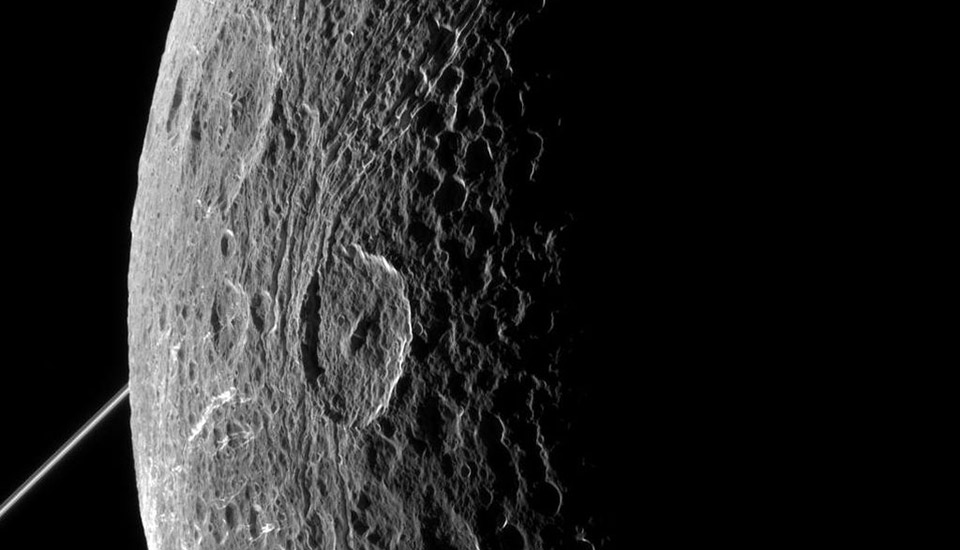
This is a photo of Dione, one of Saturn's moons. Just like the planet's most stunning images,
this picture was also captured by NASA's and ESA's Cassini spacecraft, as it flew by on June 16, 2015.
The vessel, which has been orbiting Saturn for over a decade, took the pictures in visible light
using a narrow-angle camera at an altitude of 321 miles from the moon's pockmarked surface.
While that's pretty close, the closest flyby yet happened in 2011, when Cassini flew by Dione at an altitude of 62 miles.
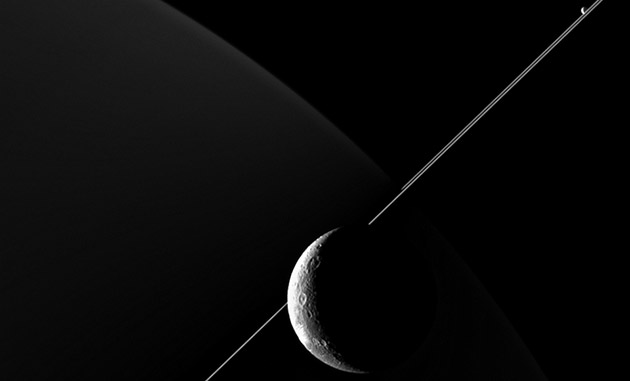
The image above was taken from 48,000 miles away, with Saturn and its rings visible in the background
and Enceladus making a cameo on the upper right portion of the pic. Enceladus is another Saturnian moon,
which astronomers believe might have warm waters, chemicals and minerals that could foster life.
Cassini's slated to pass real close to it soon -- as close as 30 miles from its surface --
and will likely take images of the icy satellite, as well.
Cassini to Make Last Close Flyby of Saturn Moon Dione
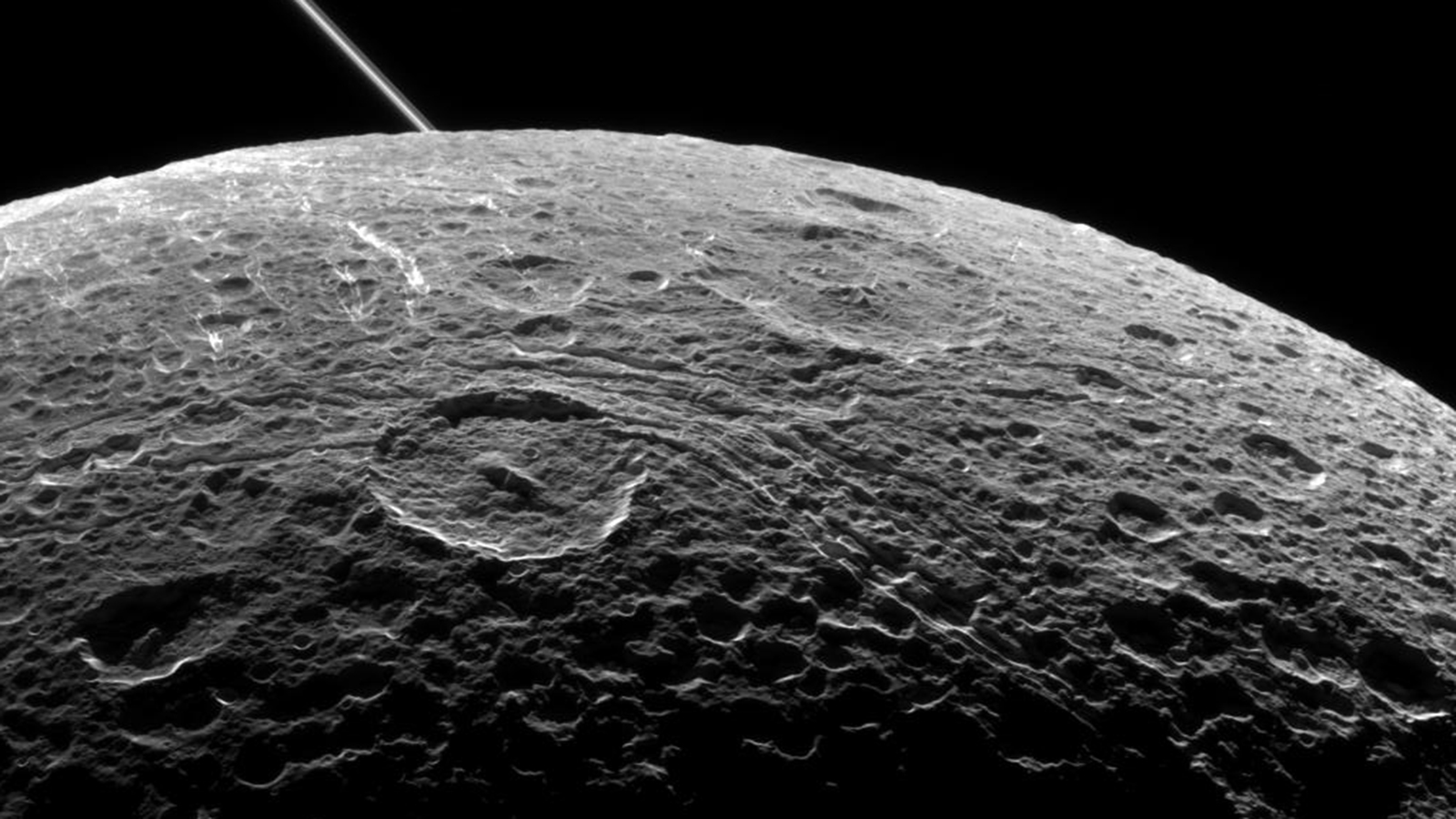
A view of Saturn's moon Dione captured by NASA's Cassini spacecraft during a close flyby on June 16, 2015.
The diagonal line near upper left is the rings of Saturn, in the distance.
Image credit: NASA/JPL-Caltech/Space Science Institute
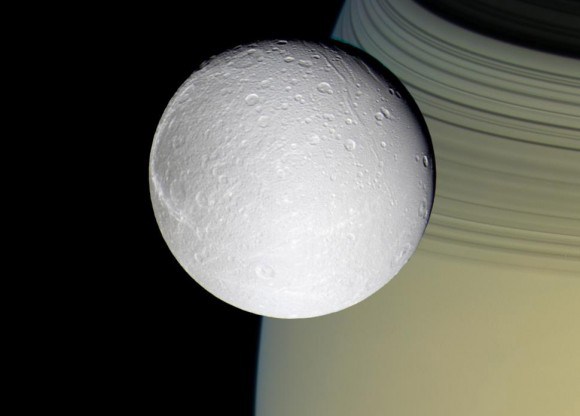
Saturn’s moon Dione, with Saturn’s rings visible in the background. Credit: NASA/JPL

Global map of Dione, showing dark red in the trailing hemisphere (left),
which is due to radiation and charged particles from Saturn’s.
Credit: NASA/JPL/Space Science Institute

Dione’s trailing hemisphere, pictured by the Cassini orbiter, which shows its patches of “wispy terrain”.
Credit: NASA/JPL
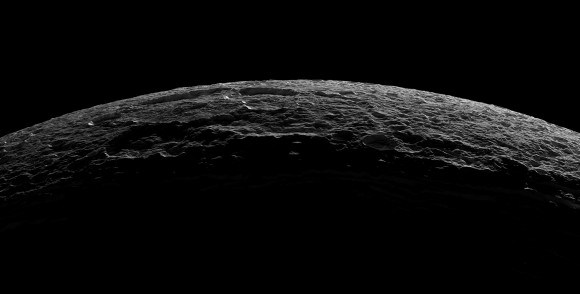
Dione viewed by Cassini on October 11th, 2005, showing the Alcander crater (top) and the larger Prytanis crater to its left.
Credit: NASA/JPL/SSI
Chasms on Dione
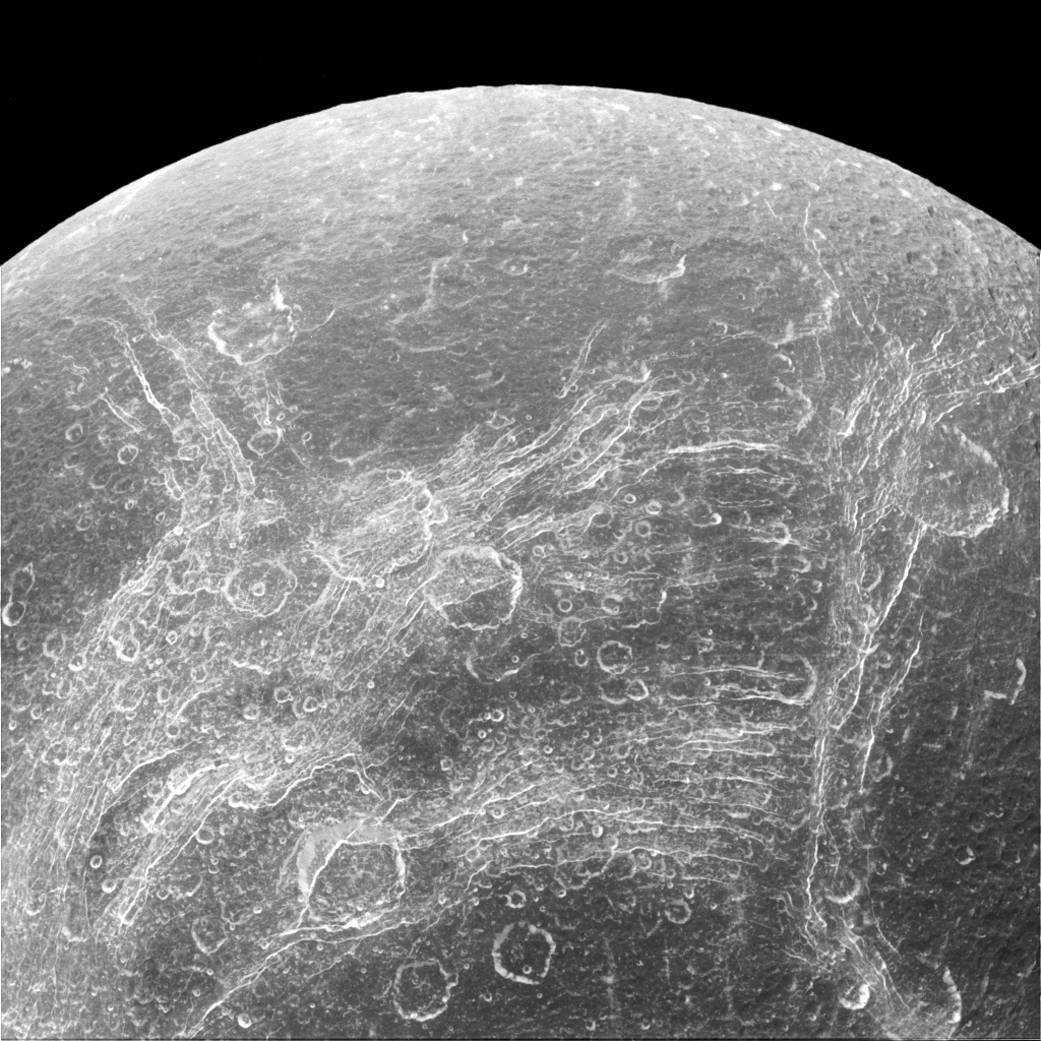
While not bursting with activity like its system sister Enceladus, the surface of Dione is definitely not boring.
Some parts of the surface are covered by linear features, called chasmata, which provide dramatic contrast to the round impact
craters that typically cover moons. The bright network of fractures on Dione (698 miles or 1123 kilometers across) was seen originally at poor resolution in
Voyager images and was labeled as "wispy terrain." The nature of this terrain was unclear until Cassini showed that they weren't
surface deposits of frost, as some had suspected, but rather a pattern of bright icy cliffs among myriad fractures.
One possibility is that this stress pattern may be related to Dione's orbital evolution and the effect of tidal stresses over time. This view looks toward the trailing hemisphere of Dione. North on Dione is up. The image was taken in visible light with the
Cassini spacecraft narrow-angle camera on April 11, 2015. The view was acquired at a distance of approximately 68,000 miles (110,000 kilometers) from Dione. Image scale is 2,200 feet (660 meters) per pixel. The Cassini mission is a cooperative project of NASA, ESA (the European Space Agency) and the Italian Space Agency.
The Jet Propulsion Laboratory, a division of the California Institute of Technology in Pasadena, manages the mission for NASA's Science Mission
Directorate, Washington. The Cassini orbiter and its two onboard cameras were designed, developed and assembled at JPL.
The imaging operations center is based at the Space Science Institute in Boulder, Colorado. For more information about the Cassini-Huygens mission visit
orFor more information about the Cassini-Huygens mission visit
or The Cassini imaging team homepage
Credit: NASA/JPL-Caltech/Space Science Institute
Last Updated: Aug. 17, 2015 Editor: Tony Greicius
Dione Dwarfing Rhea
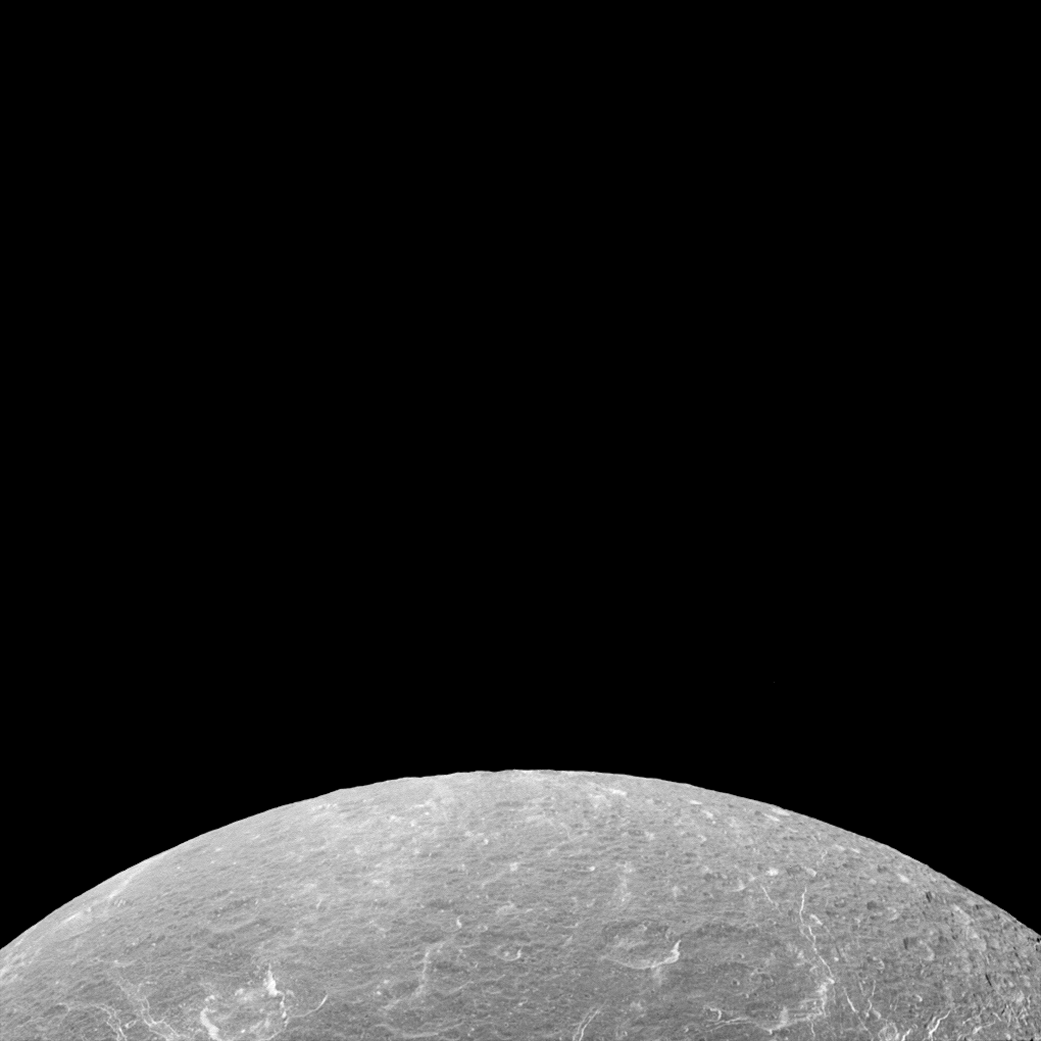
Is Dione (698 miles or 1123 kilometers across) suddenly larger than Rhea (949 miles or 1527 kilometers across)? No, of course not. Cassini simply captured an image
when Dione was much closer to the camera, making the moon appear much bigger than her larger sister moon.
Besides their beauty, images like these can help Cassini's navigators determine exactly where the spacecraft
is and confirm that it's on course.
This view looks toward the trailing hemisphere of Dione. North on Dione is up. The image was taken in visible light with the Cassini
spacecraft narrow-angle camera on April 11, 2015.
The view was obtained at a distance of approximately 68,000 miles (110,000 kilometers) from Dione and at a Sun-Dione-spacecraft,
or phase, angle of 29 degrees. Image scale at Dione is 2,165 feet (660 meters) per pixel. Rhea was 300,000 miles (500,000 kilometers)
away at a phase (Sun-Rhea-spacecraft) angle of 30 degrees. The image scale at Rhea is 2 miles (3 kilometers) per pixel.
The Cassini mission is a cooperative project of NASA, ESA (the European Space Agency) and the Italian Space Agency.
The Jet Propulsion Laboratory, a division of the California Institute of Technology in Pasadena, manages the mission for NASA's
Science Mission Directorate, Washington. The Cassini orbiter and its two onboard cameras were designed, developed and assembled at JPL.
The imaging operations center is based at the Space Science Institute in Boulder, Colorado.
For more information about the Cassini-Huygens mission visit
or For more information about the Cassini-Huygens mission visit
or. The Cassini imaging team homepage is at . Credit: NASA/JPL-Caltech/Space Science Institute Last Updated: July 30, 2015 Editor: Tony Greicius
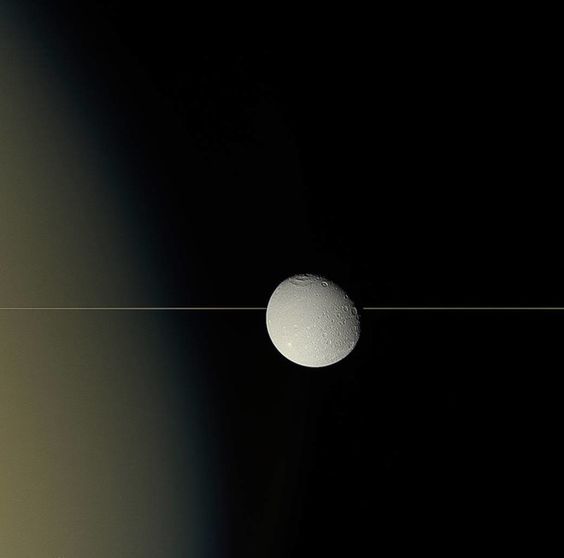
NASA's Cassini spacecraft captured this photo of the Saturn moon Dione, with the gas giant's rings edge on in the background, on Aug. 17, 2015. Cassini was about 66,200 miles (106,500 kilometers) from Dione at the time. Credit: NASA/JPL-Caltech/Space Science Institute
Click here to return to top of page
Saturn's Moon PAN
FRIED EGG? FLYING SAUCER? NOPE. JUST COOL NEW CLOSEUPS OF SATURN’S MOON PAN
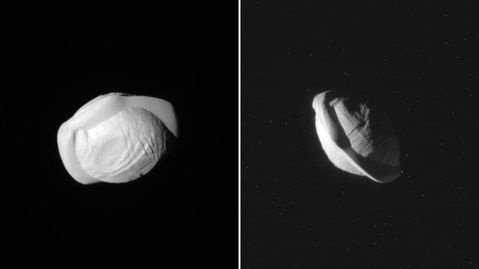
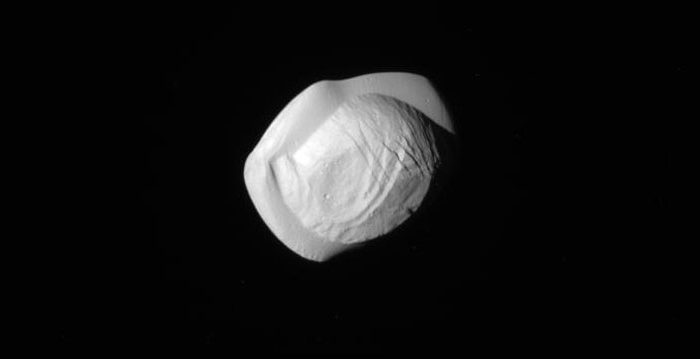
Saturn's "UFO moon" Pan up close. Credit: NASA/JPL/Space Science Institute
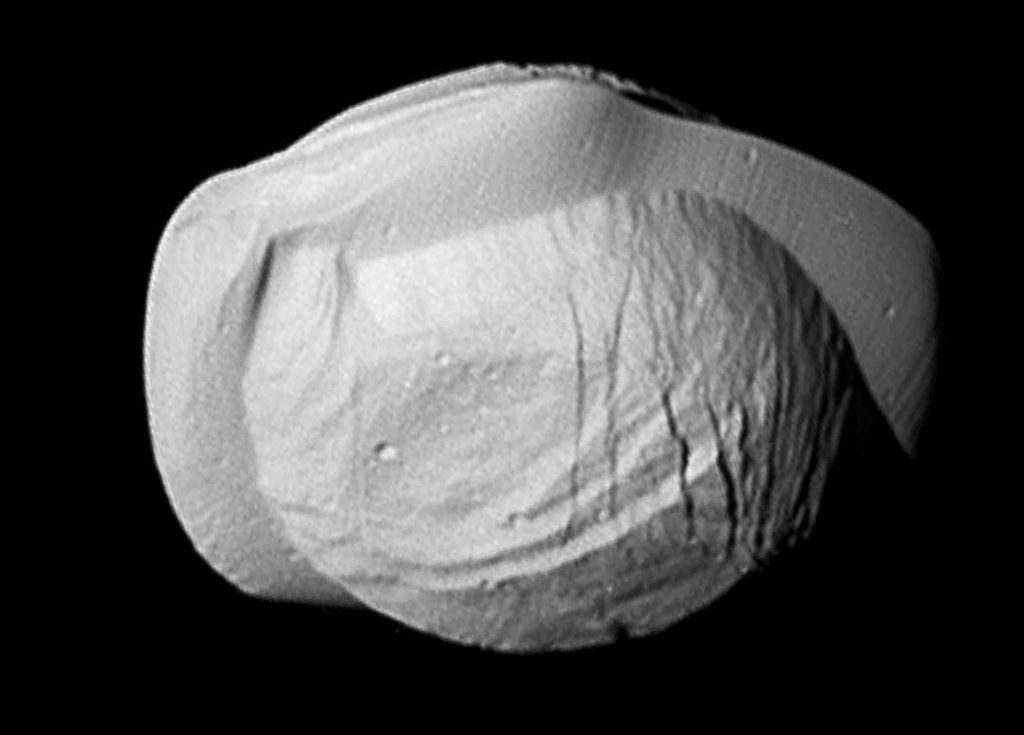
This new view of Saturn’s moon Pan is the closest yet, snapped by Cassini from a distance of 15,268 miles (24,572 km) on March 7, 2017. Pan measures 22 miles wide by 14 miles across and displays a number of small craters along with parallel ridges and grooves. Its broad, thinner equatorial ridge displays fine, parallel striations. Credit: NASA/JPL/Space Science Institute
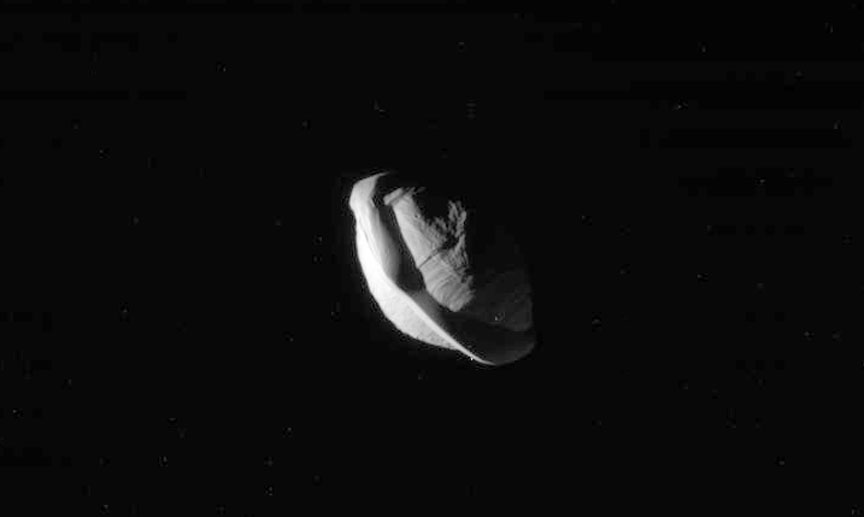
A side view of Pan better shows its thin and wavy ridge likely built up through the accumulation of particles grabbed from Saturn’s rings. The ridge is between 0.9 and 2.5 miles (1-4 km) thick. Credit: NASA/JPL/Space Science Institute
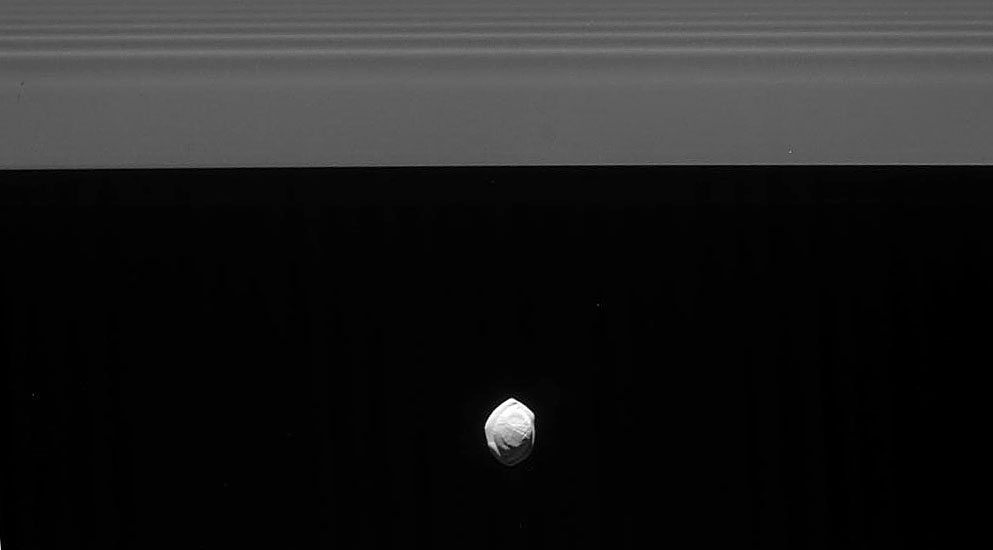
As Pan moves along the Encke Gap its gravity creates ripples in Saturn’s A-ring. Credit:NASA/JPL/Space Science Institute
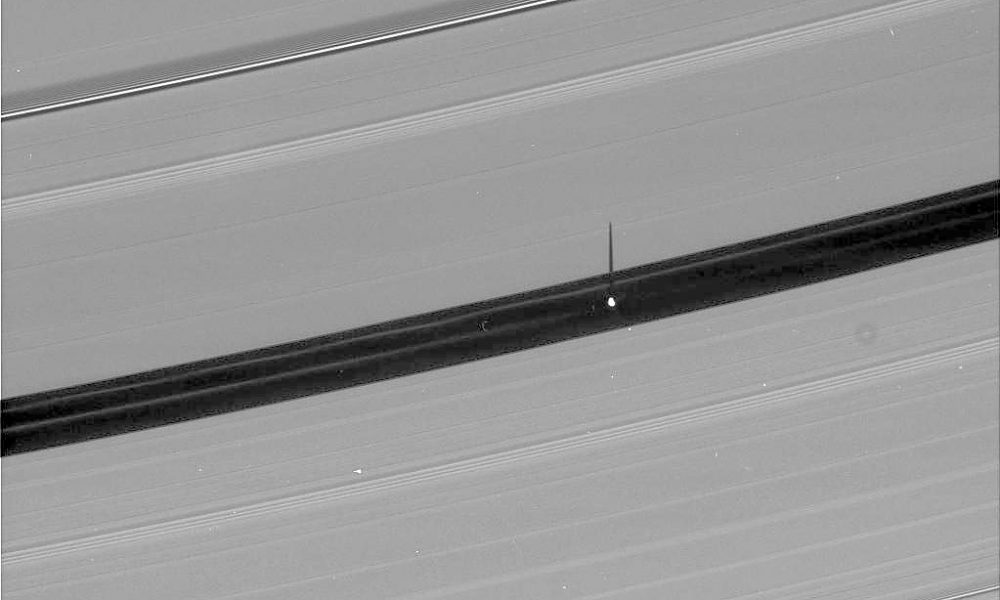
Pan casts its shadow on Saturn’s A-ring from within the 200-mile-wide (325 km) Encke Gap, which is maintained by the presence of the moon. Pan shares the gap with several diffuse ringlets from which it may still be gathering additional material around its equatorial ridge. Credit: NASA/JPL/Space Science Institute
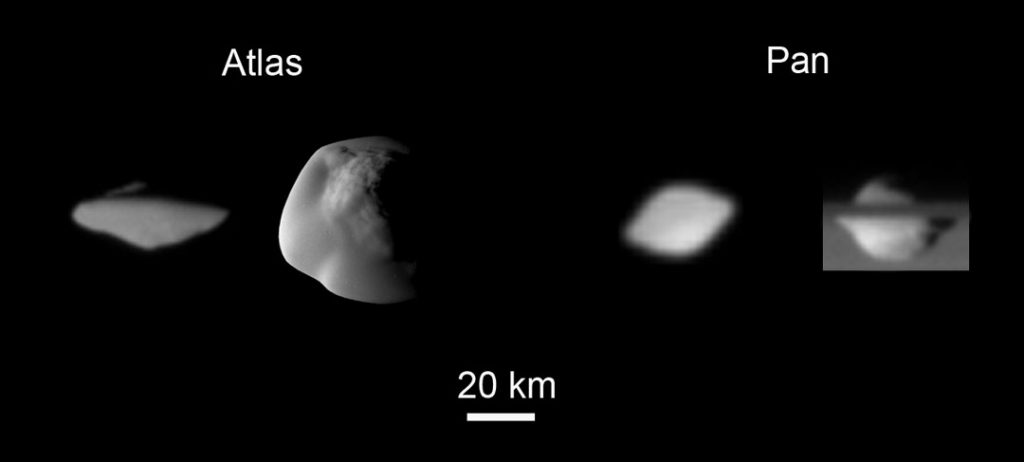
Pan and Altas (25×22 miles) orbit within Saturn’s ring plane and may both be fragments from a larger moon breakup that created Saturn’s rings. Both have swept up material from the rings to form equatorial ridges. Credit: NASA/JPL/Space Science Institute
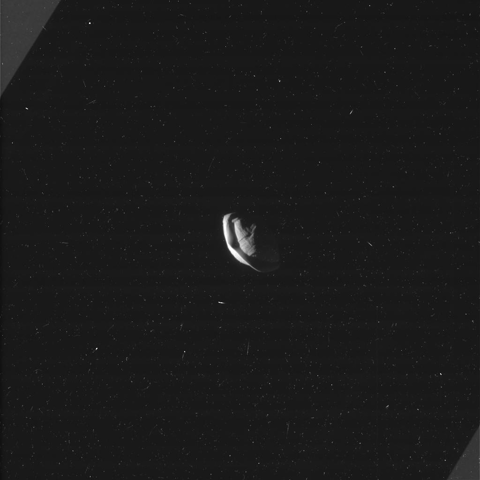
Enjoy this animated gif created from photos of the close flyby of Pan. Credit:NASA/JPL/Space Science Institute
Click here to return to top of page
Saturn's Moon OBERON
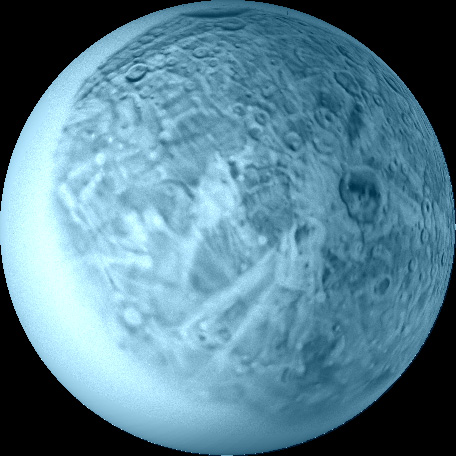
The map of Oberon showing known geological features. The large crater with the dark floor (right of center) is Hamlet. SOURCE
United States Geological Survey AstroGeologoly Maps
Information on United States Geological Survey AstroGeologoly Maps
Click here to return to top of page